
Fact Animal
Facts About Animals

Wandering Albatross Facts
Wandering albatross profile.
In 1961, Dion and the Del Satins had a song from the perspective of an albatross. It wasn’t accurate on many counts, but it did get one thing right: they get around.
The Diomedea exulans, more commonly known as the wandering albatross is perhaps the most accomplished wanderer of any animal, with routine voyages of hundreds of kilometres per day on record-breaking wings.
They are a large seabird with a circumpolar range in the Southern Ocean, and sometimes known as snowy albatross, white-winged albatross or goonie.

Wandering Albatross Facts Overview
The wandering albatross breeds on islands in the South Atlantic Ocean, such as South Georgia Island, Crozet Islands, Prince Edward Island and others.
They spend most of their life in flight , and land only to breed and feed.
These are phenomenal birds, capable of surviving some of the harshest weather conditions even at the most vulnerable stages of their development.
They are slow to reproduce, spending extra time to develop into one of the biggest and most specialised animals in the air.
Sadly, this is what makes them vulnerable to population declines, and longline fishing vessels are responsible for many adult deaths.
Interesting Wandering Albatross Facts
1. they can travel 120k km (75k) miles in a year.
The Wandering albatross might be the most wide-ranging of all foraging sea birds, and maybe of all animals. They’ve been tracked over 15,000 km in a single foraging trip, capable of speeds of up to 80 kmph and distances of over 900 km per day. 1
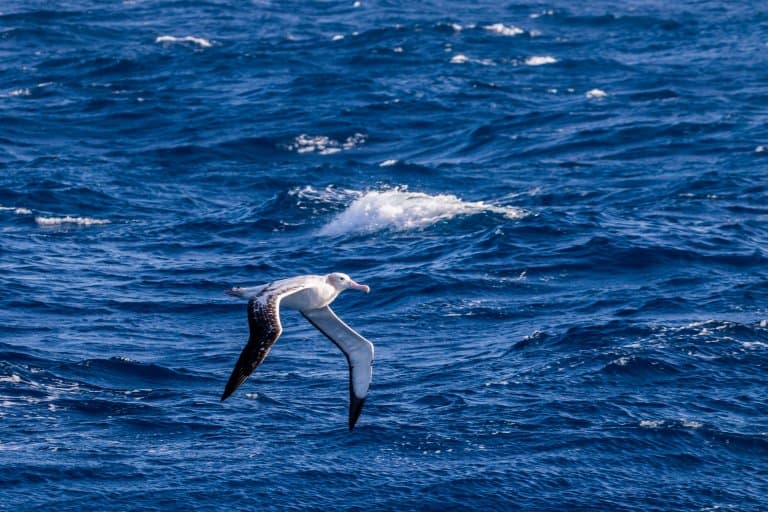
2. They’re monogamous (mostly)
This goes against the entire theme of the Del Satins song and is probably why it’s no longer used as a learning aid in the zoological curriculum.
Contrary to the promiscuous subject of the ‘60s hit, the Wandering Albatrosses mate for life and are (on average) monogamous.
When breeding, they take on incubation shifts, and it’s during these periods when the wanderer goes out on their epic voyages to return with food for their family.
Still, there’s an element of personal preference when it comes to breeding.
Most females will take a year or two off after the long and arduous task of reproduction. During this time the parents will go their separate ways, only to reunite when the time is right.
In these periods, some females will take on a temporary mate, so they can squeeze out one more chick before reuniting with their permanent nesting partner. 2
3. Wandering albatross are active in moonlight
When on these journeys, the albatross is almost constantly active. During the day they spend the entire time in the air, and while they don’t cover much distance at night, they were still recorded almost constantly moving – never stopping for more than 1.6h in the dark.
They appear to travel more on moonlit nights than on darker ones.
All of this data comes from satellite trackers attached to some birds, which are always going to skew the results.
Flying birds are optimised for weight, and trackers add to this weight, so there’s necessarily a negative effect on the individual’s fitness when lumbering them with a tracker.
Still, these subjects were able to outlast the trackers’ batteries on many occasions, and it’s safe to assume they’re capable of even more than we can realistically measure!

4. They have the largest wingspan of any bird in the world
One advantage that an albatross has over, say, a pigeon, when it comes to carrying a researcher’s hardware, is that it doesn’t need to flap much.
The albatross is the bird with the longest wingspan of any flying animal – growing up to 3.2 m (10.5 ft), and these wings are meticulously adapted for soaring.
The Guiness Book of Records claims the largest wingspan of any living species of bird was a wandering albatross with a wingspan of 3.63m (11 ft 11) caught in 1965 by scientists on the Antarctic research ship USNS Eltanin in the Tasman Sea.
Research has suggested that these wings function best against slight headwinds, and act like the sails of a boat, allowing the bird to cover more ground by “tacking”, like a sailboat: zig-zagging across the angle of the wind to make forward progress into it. 3
5. Fat chicks
As mentioned, these voyages are usually a result of foraging trips for their chicks.
The environment for a growing albatross is one of the least conducive for life. Freezing winter storms and exposed ledges make for a hilly upbringing for the baby birds.
Fed on a healthy diet of regurgitated squid, these albatross chicks grow to enormous sizes. On nesting sites, it’s not uncommon to find a fluffy baby albatross weighing up to 10kg.
These chicks are heavier than their parents, and they need the extra mass to protect them from the Winter season while they grow into fledglings. They’re also such big birds that they take longer than a season to reach maturity.
It takes around ten months of feeding, back and forth from the ocean every few days, for the parents to grow a healthy adult offspring.
6. Being a parent takes practice
When inexperienced parents were compared with those who’d brought up chicks before, it was found that their chicks are a little slower to fatten up, at least in the first few months.
Parents would feed less regularly, but with much larger amounts, and it seems to take a while to get the routine down.
By the end of the breeding season, these differences disappeared and the parents became fully qualified.
7. 25% of chicks die when they leave the colony
The huge chicks have one of the longest rearing periods of any bird, and this is after an 11-month incubation period! And if they survive all this, they still have a long way to go.
There’s a period of 3 to 7 years during which the young chick will leave the colony alone and spend the entire time at sea.
During the first two months of this learning phase, 25% of chicks die. This is a critical time for the young birds, but if they survive, they’ll return to the colony and find a mate. 4

8. They’re good sniffers
These birds feed primarily on smelly things like squid, and they’ve developed a very keen sense of smell to find them from downwind.
Wandering Albatrosses have one of the largest olfactory bulbs of any bird and they’re honed to fishy aromas.
They combine this sense with strong vision to identify productive areas of the ocean for hunting and foraging. 5
9. They are part of a ‘species complex’
When multiple species are so similar in appearance and other features, it makes their boundaries unclear and this group is known as a species complex.
The wandering albatross was long considered the same species as the Tristan albatross and the Antipodean albatross. Along with the Amsterdam albatross, they form a species complex.
Taxonomy of animals in general is tricky, and some researchers still describe them as the same species.
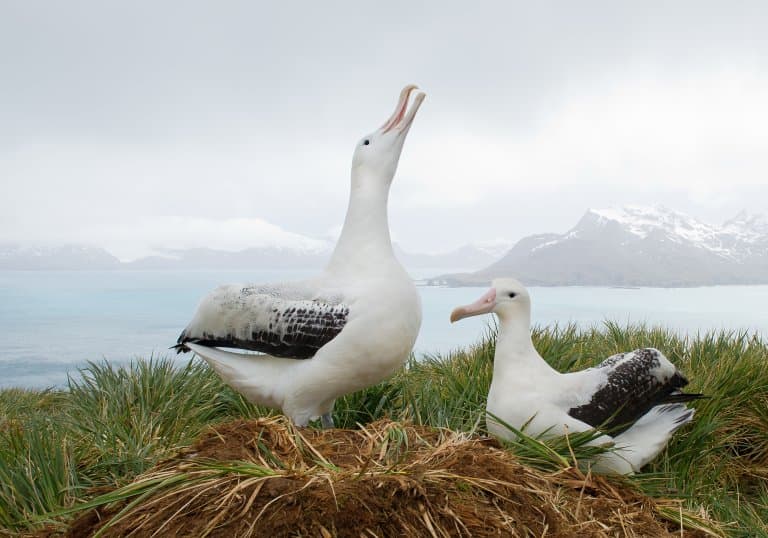
10. The wandering albatross is vulnerable
The ICUN has classified the wandering albatross as vulnerable, and the last study of their population size in 2007 indicated there were an estimated 25,000 birds.
The biggest threat to their survival is fishing, in particular longline fishing. This is where a long mainline is used with baited hooks, and they are prone to accidental catching of birds, as well as dolphins, sharks, turtles and other sea creatures. Pollution, mainly from plastics and fishing hooks is also a problem for birds such as the wandering albatross.
Convervation efforts are underway to reduce bycatch of albatrosses and some breeding islands are now classified as nature reserves.
Wandering Albatross Fact-File Summary
Scientific classification, fact sources & references.
- Jouventin, P., Weimerskirch, H (1990), “ Satellite tracking of Wandering albatrosses “, Nature.
- GrrlScientist (2022), “ Divorce Is More Common In Albatross Couples With Shy Males, Study Finds “, Forbes.
- Richardson, P. L., Wakefield, E. D., & Phillips, R. A. (2018), “ Flight speed and performance of the wandering albatross with respect to wind “, Movement Ecology.
- Weimerskirch, H., Cherel, Y., Delord, K., Jaeger, A., Patrick, S. C., & Riotte-Lambert, L. (2014), “ Lifetime foraging patterns of the wandering albatross: Life on the move! “, Journal of Experimental Marine Biology and Ecology.
- Nevitt, G. A., Losekoot, M., & Weimerskirch, H. (2008), “ Evidence for olfactory search in wandering albatross, Diomedea exulans “, Proceedings of the National Academy of Sciences.
Albatrosses
An albatross aloft can be a spectacular sight. These feathered giants have the longest wingspan of any bird—up to 11 feet! The wandering albatross is the biggest of some two dozen different species. Albatrosses use their formidable wingspans to ride the ocean winds and sometimes to glide for hours without rest or even a flap of their wings. They also float on the sea's surface, though the position makes them vulnerable to aquatic predators. Albatrosses drink salt water, as do some other sea birds.
These long-lived birds have reached a documented 50 years of age. They are rarely seen on land and gather only to breed, at which time they form large colonies on remote islands. Mating pairs produce a single egg and take turns caring for it. Young albatrosses may fly within three to ten months, depending on the species, but then leave the land behind for some five to ten years until they themselves reach sexual maturity. Some species appear to mate for life.
Albatrosses feed primarily on squid or schooling fish, but are familiar to mariners because they sometimes follow ships in hopes of dining on handouts or garbage. Albatrosses have a special place in maritime lore and superstition, most memorably evoked in Samuel Taylor Coleridge's The Rime of the Ancient Mariner .
Relationship with Humans
Some albatross species were heavily hunted for feathers that were used as down and in the manufacture of women's hats. The Laysan albatross was important to the indigenous hunters of the northern seas. Excavations of Aleut and Eskimo settlements reveal many albatross bones and suggest that the birds were an important part of human diet in the region.
- Environment
- Perpetual Planet
- History & Culture
- Paid Content
History & Culture
- Mind, Body, Wonder
- Terms of Use
- Privacy Policy
- Your US State Privacy Rights
- Children's Online Privacy Policy
- Interest-Based Ads
- About Nielsen Measurement
- Do Not Sell or Share My Personal Information
- Nat Geo Home
- Attend a Live Event
- Book a Trip
- Inspire Your Kids
- Shop Nat Geo
- Visit the D.C. Museum
- Learn About Our Impact
- Support Our Mission
- Advertise With Us
- Customer Service
- Renew Subscription
- Manage Your Subscription
- Work at Nat Geo
- Sign Up for Our Newsletters
- Contribute to Protect the Planet
Copyright © 1996-2015 National Geographic Society Copyright © 2015-2024 National Geographic Partners, LLC. All rights reserved
- Complete List of Animals
- Animals that start with A
- Animals that start with B
- Animals that start with C
- Animals that start with D
- Animals that start with E
- Animals that start with F
- Animals that start with G
- Animals that start with H
- Animals that start with I
- Animals that start with J
- Animals that start with K
- Animals that start with L
- Animals that start with M
- Animals that start with N
- Animals that start with O
- Animals that start with P
- Animals that start with Q
- Animals that start with R
- Animals that start with S
- Animals that start with T
- Animals that start with U
- Animals that start with V
- Animals that start with W
- Animals that start with X
- Animals that start with Y
- Animals that start with Z
- Parks and Zoos

- Diomedeidae
- Diomedea exulans
- Procellariiformes
Wandering Albatross
The Wandering Albatross is a massive bird known by many names. In various regions, people call this bird a Snowy Albatross, Goonie, and White Winged Albatross.
Not only are they the largest of the 22 albatross species, but they also have the longest wingspan of any bird. Their wings commonly measure up to 10 ft. across, and the largest confirmed specimen had a wingspan over 12 ft. across! Read on to learn about the Wandering Albatross .

Description of the Wandering Albatross
This species of albatross has white plumage, or feathers, with darker wings. Their wing feathers are black, and speckled with varying degrees of white. Young birds have brown feathers, which become white as they age.
This bird’s wingspan is quite large, and averages 10 feet across, though some individuals are larger. Finally, their beaks are moderately long, with a hook at the end to help grasp fish.
Interesting Facts About the Wandering Albatross
This species has the longest wingspan of any living bird … Ever! However, that is not the only notable thing about the Wandering Albatross.
- Monogamous Mates – Once a Wandering Albatross has found a suitable mate, it continues to breed with that bird for the rest of its life. They are doting parents, and take great care in rearing their chicks. It sometimes takes up to 10 months for the chick to learn how to fly and become independent of its parents.
- Time Constraints – Obviously when it takes 10 months to raise a single chick, it can be difficult to jump right back into parenthood. For this reason, Wandering Albatrosses breed once every 2 years.
- Slow to Mature – Adult albatrosses don’t even begin reproducing until they are about 10 years old on average. They sometimes join the other birds at the breeding colonies and perform mating displays. However, most of the time they do not find a mate and begin to breed until they are around 10 years old.
- Slow Growth – Unfortunately, because these birds are so slow to mature, and they breed at a very slow rate, their populations do not increase quickly. Because of this, when their populations decline it takes a long time for them to make a comeback. Humans pose threats to these birds in a number of different ways, and the IUCN lists the species as Vulnerable .
Habitat of the Wandering Albatross
These birds spend the vast majority their life flying over, or floating on the surface of, the ocean. They inhabit the open ocean, primarily where the waters are deep, and fish are plentiful. The only time they come to land is for the mating season. During this time, colonies of birds land on plateaus, valleys, and plains.
Distribution of the Wandering Albatross
There are several different subspecies of Wandering Albatross, all of which live in the open oceans of the Southern Hemisphere. Outside of the breeding season, they roam the open oceans in between Antarctica and the southern coasts of Africa, South America, and Australia. Their primary breeding colonies are on various islands across the Southern Hemisphere, including South Georgia, Macquarie, Amsterdam Island, and more.
Diet of the Wandering Albatross
This seabird unsurprisingly feeds primarily on fish and other aquatic organisms. They eat fish, octopus, squid, shrimp, and krill.
They also scavenge on the remains of carcasses, as well as feeding on the scraps from commercial fishing operations and other predators. Though they can dive if they need to, they catch most of their food at the surface of the water.
Wandering Albatross and Human Interaction
Unfortunately, humans are extremely detrimental to these birds. Sailors have killed birds, both at sea and in nesting colonies, for decades. In fact, humans are the only known predator of adult albatrosses.
Nowadays it is illegal to harm these birds, though killing does still occur. Sadly, they frequently, and accidentally, become trapped in fishing nets or on fishing lines. Humans have also introduced many different feral animals to their breeding islands, and these animals eat the eggs and chicks.
Domestication
Humans have not domesticated this species of bird in any way.
Does the Wandering Albatross Make a Good Pet
No, the Wandering Albatross does not make a good pet. Their huge wings carry them across open ocean, which would make them a poor household pet. It most places, it is illegal to harm, harass, capture, or kill these birds.
Wandering Albatross Care
These birds do not often find themselves in zoos. The only time any albatross species lives in a zoo or aquarium is when something has severely injured them in some way.
During those times, zoos attempt to heal and rehabilitate the birds, and release them back into the wild if possible. Albatrosses that live in zoos because they cannot survive in the wild act as ambassadors to the plight of their species.
Behavior of the Wandering Albatross
This species is quite social, even outside of the breeding season. While in the open ocean, small groups of Wandering Albatrosses forage together. These groups frequently converge upon one another when feeding opportunities, like bait balls or fishing vessels, arise.
As the breeding season arrives, huge colonies of birds flock to their breeding grounds together. Birds searching for mates perform elaborate courtship displays, and mated pairs renew their bonds.
Reproduction of the Wandering Albatross
Every 2 years a pair breeds and produces a single egg, usually in December. Both the male and the female help incubate the egg, which hatches after 2.5 months. Once the chick hatches the parents alternate between keeping it warm and fishing for food.
After the chick is a month old, both parents leave it alone to hunt for food. It takes between 9 and 10 months for the chick to learn how to fly and gain independence.
RELATED ARTICLES MORE FROM AUTHOR
![Red Angus Closeup of a beautiful Red Angus cowPhoto by: U.S. Department of Agriculture [pubic domain]https://creativecommons.org/licenses/by/2.0/](https://animals.net/wp-content/uploads/2020/03/Red-Angus-4-238x178.jpg)
Paint Horse

Expert Recommendations

Best Senior Dog Food

Best Grain Free Dog Food

Best Dog Training Treats

Best Dog Life Jacket

Best Dog Ear Cleaner

Best Cat Stain Odor Remover

Best Raw Dog Food

Best Canned Cat Food

Best Dog Beds for Large Dogs

Best Dog Seat Cover
Even more news.
![Red Angus Closeup of a beautiful Red Angus cowPhoto by: U.S. Department of Agriculture [pubic domain]https://creativecommons.org/licenses/by/2.0/](https://animals.net/wp-content/uploads/2020/03/Red-Angus-4-100x75.jpg)
House Spider
Popular category.
- Chordata 694
- Mammalia 247
- Dog Breeds 184
- Actinopterygii 121
- Reptilia 87
- Carnivora 72
- Privacy Policy
- Terms and Conditions

Smithsonian Ocean
Wandering albatross.

A wandering albatross has the largest wingspan of any bird, 3.5 meters (11.5 feet) tip to wing tip.
- Make Way for Whales
- Sharks & Rays
- Invertebrates
- Plants & Algae
- Coral Reefs
- Coasts & Shallow Water
- Census of Marine Life
- Tides & Currents
- Waves, Storms & Tsunamis
- The Seafloor
- Temperature & Chemistry
- Ancient Seas
- Extinctions
- The Anthropocene
- Habitat Destruction
- Invasive Species
- Acidification
- Climate Change
- Gulf Oil Spill
- Solutions & Success Stories
- Get Involved
- Books, Film & The Arts
- Exploration
- History & Cultures
- At The Museum
Search Smithsonian Ocean
Albatrosses: Facts about the biggest flying birds
The biggest flying bird in the world can go for years without touching land, has complicated, comical mating dances that take years to learn, and might even help scientists track down illegal fishing vessels.
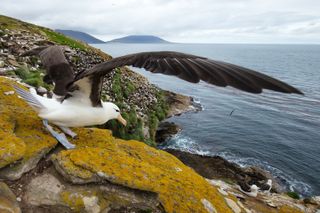
Albatrosses are big, majestic birds that can be found soaring above most of the world’s oceans.
These frequent fliers are known for spending months in the air without touching down, as well as having some unique mating arrangements. However, thanks to harmful fishing techniques and predation by invasive species, albatrosses around the world are either under threat or endangered.
There are 23 species of albatrosses, though arguably the most famous is the wandering albatross ( Diomedea exulans ), which is the largest flying bird in the world. This bird has a 11-foot (3.4 meter) wingspan, according to the Encyclopedia Britannica — even bigger than the famous California condor — and it uses those massive flappers to travel thousands of miles in a single journey.
Related: Your dumb party balloons are killing all the seabirds
A life in the air
But rather than flapping its wings, wandering albatrosses (and many other large albatrosses) travel such far distances by holding their extended wings in place so that the air rushing around the wings generates lift, similar to an airplane's wings. An airplane forces air over its wings with an engine, whereas albatross take advantage of the extremely windy latitudes in the southern oceans.
This latitude range is "called the 'roaring 40s' and 'furious 50s' for a reason," said Andrea Angel, the Albatross Task Force manager with Birdlife South Africa, a nonprofit organization dedicated to bird conservation. With near constant wind in their environment, albatrosses are able to "lock their elbow joints and literally just fix their wings [in place] and just glide," Angel said. The birds also use something called "dynamic soaring," which involves changing the angle of their wings relative to the wind, to maximize the lift generated — a similar technique could help unmanned research aircraft stay aloft for months, the Independent reported .
Related: A hot blob in the Pacific Ocean caused 1 million seabirds to die
An albatross can go a year or more without setting foot on land, Angel said, although the birds do touch down in water in order to feed on the squid and fish that make up their diet. In fact, it's the tiny alpine swift, not the albatross, that holds the record for non-stop distance flying, as reported in a 2013 study published in the journal Nature Communications .
As for sleep, Angel said that it's very likely that albatrosses sleep on the wing. A 2016 study published in Nature Communications described how a distant cousin of the albatross, the frigatebird, has many, seconds-long periods of sleep while flying, suggesting that sleeping in the air is definitely possible for other long-distance traveling seabirds. And, based on microchip-tracked movements of albatrosses, "they can [fly] for hours on end, and so it is theorized that they do sleep on the wing," Angel said. "It's an accepted fact [that] because of their movements, they have to sleep."

All albatrosses are very long-lived. The oldest wild bird in the world is a Laysan albatross ( Phoebastria immutabilis ) named Wisdom, who was tagged in 1956 at the Laysan albatross colony at Midway Atoll in the North Pacific Ocean when she was already a mature adult. That makes her at least 66 years old, but she's likely older, and she's still going strong — as of 2018 she was still raising chicks, NPR reported . According to Breck Tyler, a lecturer at the University of California, Santa Cruz and retired research scientist who studied the Laysan albatross colony on Midway Atoll for decades, there are other Laysan albatrosses just a few years younger than Wisdom, so "she's probably not an outlier."
Related: World's oldest wild breeding bird is expecting her 41st chick
Although they're seabirds, albatrosses are generally poor divers, with few exceptions. The wandering albatross can only dive about 2 to 3 feet (0.6 to 1 m) into the ocean, yet based on an analysis of its diet, scientists are pretty sure the wandering albatross eats squid that live deeper in the water, and are too big for an albatross to convincingly take down. It's possible the large bird just waits until a squid swims up to the surface, but a more convincing hypothesis is that the birds are actually eating squid bits that have been vomited up by whales, as described in a 1994 study published in the journal Antarctic Science .
After a meal of whale upchuck, an albatross might wash that down with some refreshing seawater. All seabirds have a gland above their eyes that functions like a miniature kidney, allowing them to drink salt water and excrete it through the tip of their beak, according to the Travis Audubon Society .
Albatrosses mate for life, but aren't exclusive
Because albatrosses mate for life, picking the right partner is a major decision. All species of albatross have some sort of complicated mating dance. For the Laysan albatross, the dance has 24 separate, complex steps, and it takes years for males to learn them all, Tyler said. And until the young males can master the choreography, they won't find a mate, he said. The females can afford to be picky, so if a male's sequence of honks, whistles, wiggles and neck thrusts doesn't impress her, she'll just move on to the next suitor.

But once a pair does form, the "divorce rate" of albatrosses is among the lowest in the animal kingdom, and because albatrosses are so long-lived, these pairs can persist for decades. For this reason, it's been posited that albatrosses are the "most romantic" bird. But that human characterization ignores some key facts about albatrosses, Tyler said.
An albatross mating pair only sees each other a few days a year, when they meet at their breeding grounds. After a few days of catching up, the pair takes turns incubating the egg; one stays behind while the other forages for food. After about 90 days, and when the chick is big enough, the mating pair go their separate ways for the rest of the year, according to the Cornell Lab’s All About Birds .
Related: Adorable photos of baby shorebirds
Although they mate for life, albatross pairs aren't exclusive. Casual sex between non-paired birds, and even forced copulation, is not uncommon, the New York Times reported in 2010 . A 2006 study published in the journal IBIS found that out of 75 wandering albatross couples, about eight had chicks that weren't fathered by their mother's primary mate.
And in many albatross species, female-female pairs are quite common (so far, male-male pairs haven't been reported), as Live Science has previously reported . Those females rely on "cheating" paired males or unpaired males to fertilize their eggs, and then the two females raise a clutch of two eggs together, without a male's involvement, the Times reported. Laysan albatross males and females look virtually identical, so unless you were specifically looking for evidence of same-sex pairs, you'd likely miss them, the Times said — and it's likely that many other species of birds, especially if there aren't enough males to go around, form similar pair bonds, Tyler said.
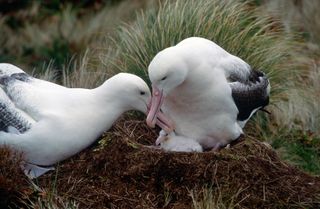
Threats to albatrosses
All but one species of albatross are either threatened, endangered or likely to become so, according to the International Union for the Conservation of Nature . The biggest threats are invasive species at the birds' nesting grounds, and fishing vessels, which unintentionally snare birds when they're pursuing tuna and other commercial fish, Angel said.
Many of the world's albatrosses nest on islands that were once used as whaling vessel stopovers, Angel explained. With the human ships came cats and rats and mice. Gough Island in the South Atlantic, for example, is one of the most important seabird colonies, home to 24 different species of birds and multiple types of albatross. But the colony is gruesomely preyed upon by invasive mice that have evolved to be a much larger than normal size without the presence of predators, Hakai magazine reported .
Perhaps because they have no other predators that would attack them this way, Albatross have not evolved a way to defend themselves against a mouse attack, and so some of the adults sit motionless, letting "the mice nibble on their flesh while they steadfastly incubate their egg." On a number of important bird islands, conservationists are launching aggressive mouse-eradication programs to attempt to save the remaining birds, National Geographic reported .
Related: In photos: Mice brutally attack and devour albatross on Gough Island
At sea, albatrosses face a different threat: fishing vessels. Albatrosses are pretty good at detecting fishing vessels — so good that researchers think the birds, outfitted with tiny radar detectors, could be used to find boats operating illegally, The New York Times reported.
Large fishing vessels have onboard processing facilities where fish heads and tails and guts are removed and dumped back into the sea, which attracts all sorts of seabirds. "It is a seabird spectacle," Angel said. But as the trawler is dumping fish guts, it's simultaneously dropping the giant fishing net back into the ocean for the next catch. Seabirds, including albatrosses, get entangled in the net cables and dragged under water, then drown. And longline fishing boats, in which a 30-mile-long (48 kilometer) floating fishing line is set with hundreds of baited hooks, also attract seabirds which see the enticing meal from the surface, but get caught on the hooks and drown.
BirdLife South Africa has reduced albatross deaths in the local trawl fishery by 99% by simply encouraging boats to use bird-scaring streamers and shifting the time that the boats dump out the fish waste to after the net is set. But worldwide there's still much more work to be done when it comes to encouraging commercial fishers to practice more seabird-friendly fishing techniques.
Additional resources:
- Learn more about the relationship between birds and humans on Midway Atoll with this feature from American Bird Conservancy
- Watch a Laysan albatross perform its complicated (and comical) mating dance .
- View not-quite-live-cam shots of albatrosses on Bird Island near the Antarctic Circle on BirdLife International’s Facebook page .
Sign up for the Live Science daily newsletter now
Get the world’s most fascinating discoveries delivered straight to your inbox.

Rachel is a writer and editor based in Washington, D.C., who covers a range of topics for Live Science, from animals and global warming to technology and human behavior. Rachel also contributes to National Geographic News, Smithsonian Magazine and Scientific American, and she is currently a senior editor at Next City, a national urban affairs magazine. She has an English degree with a journalism concentration from Adelphi University in New York.
East Africa's Lake Nakuru almost doubled in size in 13 years — and that's bad news for flamingos
World's oldest wild bird is 'actively courting' after losing long-term mate
'Uncharted territory': El Niño to flip to La Niña in what could be the hottest year on record
Most Popular
- 2 The universe may be dominated by particles that break causality and move faster than light, new paper suggests
- 3 Nightmare fish may explain how our 'fight or flight' response evolved
- 4 Intel unveils largest-ever AI 'neuromorphic computer' that mimics the human brain
- 5 Lyrid meteor shower 2024: How to watch stunning shooting stars and 'fireballs' during the event's peak this week
- 2 2,500-year-old skeletons with legs chopped off may be elites who received 'cruel' punishment in ancient China
- 3 Giant, 82-foot lizard fish discovered on UK beach could be largest marine reptile ever found
- 4 The universe may be dominated by particles that break causality and move faster than light, new paper suggests
- 5 Intel unveils largest-ever AI 'neuromorphic computer' that mimics the human brain

Wandering Albatross
Diomedea exulans.
The snowy albatross, also known as the white-winged albatross or goonie, is a majestic seabird belonging to the Diomedeidae family. It is recognized for its impressive wingspan, which is the largest of any living bird, and its predominantly white plumage that becomes whiter with age. The snowy albatross is distinguished by its large pink bill and feet, and the males exhibit whiter wings than females.
Identification Tips
Adult snowy albatrosses have white bodies contrasted with black and white wings. The wings of males are predominantly white, with only the tips and trailing edges presenting as black. This species is the whitest within its complex, with others showing more brown and black on the wings and body. A salt gland above their nasal passage helps them excrete excess salt due to their oceanic diet.
The snowy albatross boasts a wingspan that can exceed 3.5 meters (11 feet), with an average span of around 3.1 meters (10 feet 2 inches). Body length ranges from 107 to 135 cm (3 feet 6 inches to 4 feet 5 inches), with females being slightly smaller than males. Adults typically weigh between 5.9 to 12.7 kg (13 to 28 lb).
Distribution and Habitat
This bird has a circumpolar range in the Southern Ocean and breeds on islands such as South Georgia, Crozet, Kerguelen, Prince Edward, and Macquarie. It is also seen feeding year-round off the coast of New Zealand and is known for its extensive flights, sometimes circumnavigating the Southern Ocean three times in a year.
The snowy albatross is a far-ranging bird, spending most of its life in flight and landing only to breed and feed. It is capable of gliding for hours without flapping its wings, thanks to its large wingspan.
Song & Calls
During courtship, snowy albatrosses engage in a variety of displays, including spreading their wings, head-waving, bill-rapping, and producing a range of vocalizations from screams and whistles to grunts and bill clapping.
Snowy albatrosses are monogamous, often mating for life, and breed biennially. They lay a single white egg with a few spots in a large grassy nest. Incubation takes about 11 weeks, with both parents sharing the responsibility. The chicks are nurtured by both parents, who take turns foraging for food.
Similar Species
The snowy albatross is part of the wandering albatross species complex, which includes the Tristan albatross and the Antipodean albatross. It can be distinguished from its relatives by its whiter plumage and larger size.
Diet and Feeding
These birds feed on cephalopods, small fish, and crustaceans, often foraging further out in the open ocean than other albatross species. They are known to follow ships and can make shallow dives to capture their prey.
Conservation Status
The IUCN lists the snowy albatross as vulnerable. Threats include longline fishing and pollution. Conservation measures have been implemented in some regions to reduce bycatch and protect their breeding grounds.
.css-1cn5y0j{border-radius:0.25rem;font-size:0.875rem;line-height:1.25rem;font-weight:650;letter-spacing:0em;--tw-text-opacity:1;color:rgb(45 49 66 / var(--tw-text-opacity));font-style:normal;font-weight:650;margin-left:2rem;margin-right:2rem;margin-bottom:1.5rem;font-size:1.875rem;line-height:2.25rem;}@media (min-width: 768px){.css-1cn5y0j{margin-left:3rem;margin-right:3rem;}} Wandering Albatrosses on Birda
More albatrosses, amsterdam albatross, antipodean albatross, tristan albatross, southern royal albatross, northern royal albatross, short-tailed albatross, laysan albatross, waved albatross, black-footed albatross, sooty albatross, light-mantled albatross, buller's albatross, indian yellow-nosed albatross, shy albatross, atlantic yellow-nosed albatross, grey-headed albatross, chatham albatross, campbell albatross, black-browed albatross, salvin's albatross, your birdwatching journey like never before, connect with nature in minutes, discover the joy of birding, play your part in saving nature.

What Our Birders Say
Simply fantastic, fun way to add to your birdwatching experience, great app for learning birds, ideal birdwatch companion, a great app, awesome birding community, very good database, a mordern game changer, the best bird logging app.

You are using an outdated browser. Please upgrade your browser to improve your experience and security.

- Buy Tickets
- Join & Give
Wandering Albatross
- Updated 28/07/23
- Read time 2 minutes
- Share this page:
- Share on Facebook
- Share on Twitter
- Share on Linkedin
- Share via Email
- Print this page

- IUCN Conservation Status VULNERABLE (VU)
- Classification Genus Diomedea Species exulans Family Diomedeidae Order Procellariiformes Class Aves
- Size Range 80 cm to 135 cm
The Wandering Albatross is the largest of the albatrosses and is the living bird with the greatest wingspan, measuring almost 3.5 m.
What do Wandering Albatrosses look like?
Identification.
The adult Wandering Albatross appears entirely white from a distance. Close up, the fine black wavy lines on the breast, neck and upper back become visible. The bill can vary in colour, but is normally yellowish-pink. The white tail is occasionally tipped with black and the back of the wing changes from black to white with age. A series of plumage phases are passed through as young birds reach full adult plumage, which can take up to nine years. Females are slightly smaller than males.
Where do Wandering Albatrosses live?
Wandering Albatrosses spend most of their life in flight, landing only to breed and feed. Distances travelled each year are hard to measure, but one banded bird was recorded travelling 6000 km in twelve days.
Distribution
The Wandering Albatross visits Australian waters from Fremantle, Western Australia to northern New South Wales between June and September each year. At other times birds roam the southern oceans and commonly follow fishing boats for several days.
What do Wandering Albatrosses eat?
Feeding and diet.
Wandering Albatrosses are often seen scavenging scraps from fishing boats, but squid and fish are the preferred foods. Galley refuse and floating waste also form part of the diet. Feeding is one of the few times that birds land, and this is mostly undertaken at night.
What are Wandering Albatrosses breeding behaviours?
Breeding behaviour/s.
Pairs of Wandering Albatrosses mate for life and breed every two years. Breeding takes place on subantarctic islands and commences in early November. The nest is a mound of mud and vegetation, and is placed on an exposed ridge near the sea. During the early stages of the chick's development, the parents take turns to sit on the nest while the other searches for food. Later, both adults hunt for food and visit the chick at irregular intervals.
Breeding Season: November.

The Australian Museum respects and acknowledges the Gadigal people as the First Peoples and Traditional Custodians of the land and waterways on which the Museum stands.
Image credit: gadigal yilimung (shield) made by Uncle Charles Chicka Madden
Wandering Albatross
These remarkably efficient gliders, named after the Greek hero Diomedes, have the largest wingspan of any bird on the planet
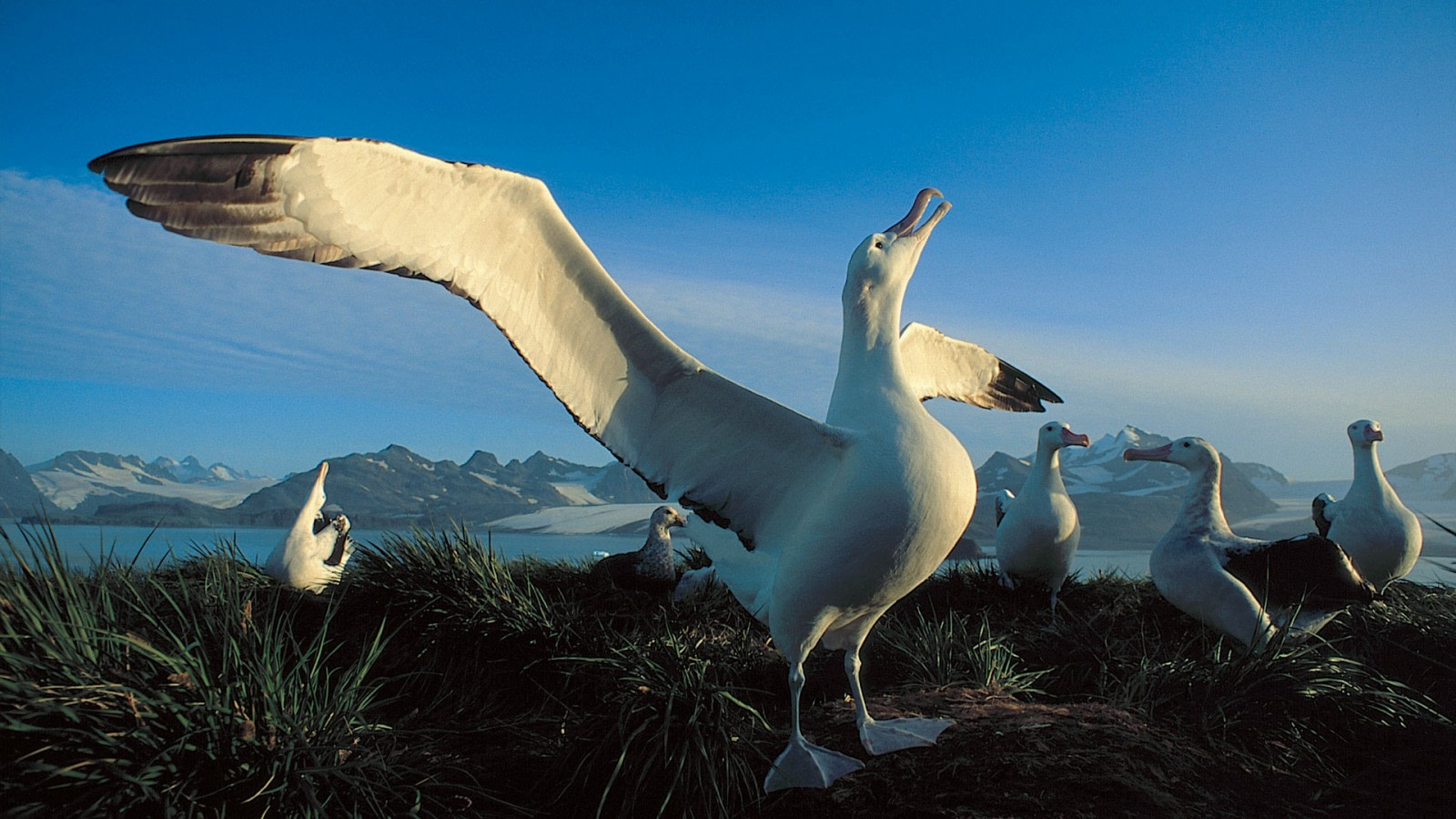
Region: Antarctica
Destinations: Bouvet Island, Antarctic Peninsula, South Georgia
Name : Wandering Albatross, Snowy Albatross, White-winged Albatross ( Diomedea exulans )
Length: Up to 135 cm.
Weight : 6 to 12kg.
Location : All oceans except in the North Atlantic.
Conservation status : Vulnerable.
Diet : Cephalopods, small fish, crustaceans.
Appearance : White with grey-black wings, hooked bill.
How do Wandering Albatrosses feed?
Wandering Albatrosses make shallow dives when hunting. They’ll also attempt to eat almost anything they come across and will follow ships in the hopes of feeding on its garbage. They can gorge themselves so much that they become unable to fly and just have to float on the water.
How fast do Wandering Albatrosses fly?
Wandering Albatrosses can fly up to 40 km per hour.
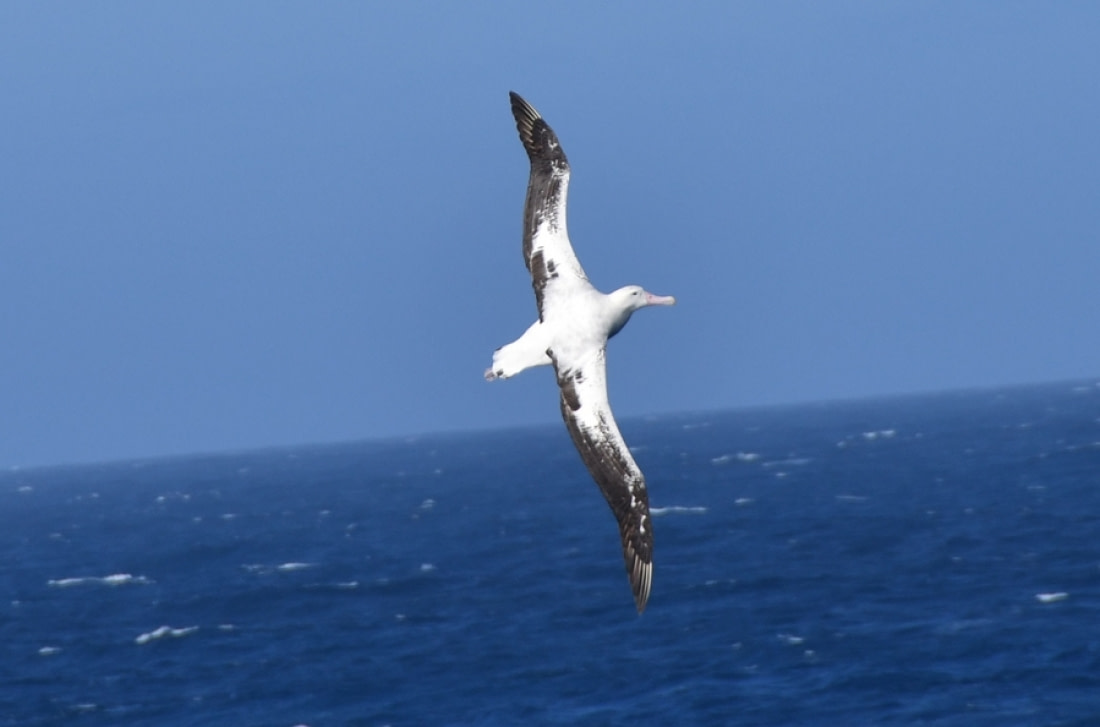
What are Wandering Albatross mating rituals like?
Wandering Albatrosses mature sexually around 11 years of age. When courting, the male Wandering Albatross will spread his wings, wave his head around, and rap his bills against that of the female while making a braying noise. The pair will mate for life, breeding every 2 years. Mating season starts in early November with the Albatrosses creating nests of mud and grass on one of the Sub-Antarctic islands. The female will lay 1 egg about 10 cm long, sometime between the middle of December and early January. Incubation takes around 11 weeks, the parents taking turns. Once the chick is born the adults switch off between hunting and staying to care for the chick. The hunting parent returns to regurgitate stomach oil for the chick to feed on. Eventually both parents will start to hunt at the same time, visiting with the chick at widening intervals.
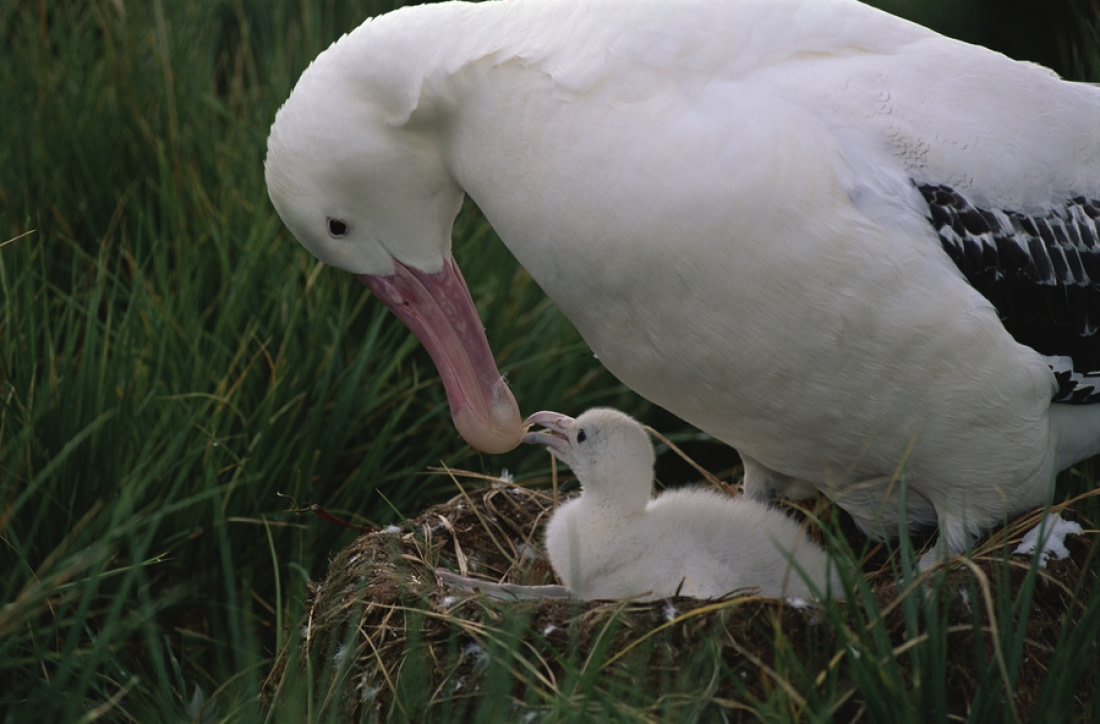
How long do Wandering Albatrosses live?
Wandering Albatrosses can live for over 50 years.
How many Wandering Albatrosses are there today?
There are about 25.200 adult Wandering Albatrosses in the world today.
Do Wandering Albatrosses have any natural predators?
Because they’re so big and spend almost all of their lives in flight, Wandering Albatrosses have almost no natural predators.
7 Wonderful Wandering Albatross Facts
- The Wandering Albatross is the largest member of its genus ( Diomedea ) and is one of the largest birds in the world.
- Wandering Albatrosses are also one of the best known and most studied species of birds.
- Diomedea refers to Diomedes, a hero in Greek mythology; of all the Acheaens he and Ajax were 2 nd only to Achilles in prowess. In mythology all of his companions turned into birds. Exulans is Latin for “exile” or “wanderer.”
- Wandering Albatrosses have the largest wingspan of any bird in the world today, stretching up to 3.5 metres across.
- Wandering Albatrosses are great gliders – they can soar through the sky without flapping their wings for several hours at a time. They’re so efficient at flying that they can actually use up less energy in the air than they would while sitting in a nest.
- Wandering Albatrosses have a special gland above their nasal passage that excretes a high saline solution. This helps keep salt level in their body, combating all the salt water they take in.
- Wandering Albatrosses get whiter the older they get.

Related cruises
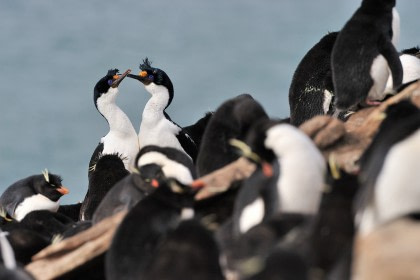
Falkland Islands - South Georgia - Antarctica
Meet at least six penguin species!
PLA20-24 A cruise to the Falkland Islands, South Georgia & the Antarctic Peninsula. Visit some of the most beautiful arrays of wildlife on Earth. This journey will introduce you to at least 6 species of penguin and a whole lot of Antarctic fur seals!
m/v Plancius
Cruise date:
18 Oct - 7 Nov, 2024
Berths start from:
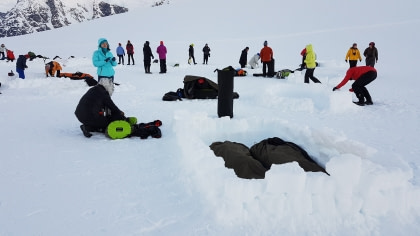
Antarctica - Basecamp - free camping, kayaking, snowshoe/hiking, photo workshop, mountaineering
The best activity voyage in Antarctica
HDS21a24 The Antarctic Peninsula Basecamp cruise offers you a myriad of ways to explore and enjoy the Antarctic Region. This expedition allows you to hike, snowshoe, kayak, go mountaineering, and even camp out under the Southern Polar skies.
m/v Hondius
1 Nov - 13 Nov, 2024
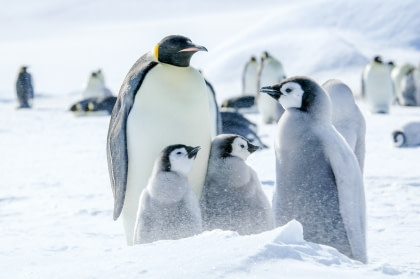
Weddell Sea – In search of the Emperor Penguin, incl. helicopters
Searching for the Elusive Emperor Penguins
OTL22-24 A true expedition, our Weddell Sea cruise sets out to explore the range of the Emperor Penguins near Snow Hill Island. We will visit the area via helicopter and see a variety of other birds and penguins including Adélies and Gentoos.
m/v Ortelius
10 Nov - 20 Nov, 2024
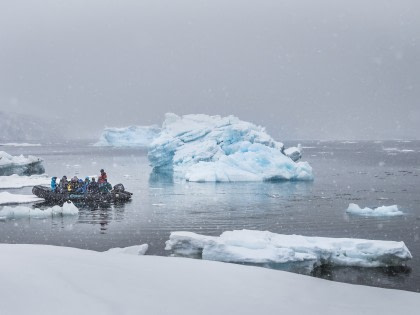
OTL23-24 A true expedition, our Weddell Sea cruise sets out to explore the range of the Emperor Penguins near Snow Hill Island. We will visit the area via helicopter and see a variety of other birds and penguins including Adélies and Gentoos.
20 Nov - 30 Nov, 2024
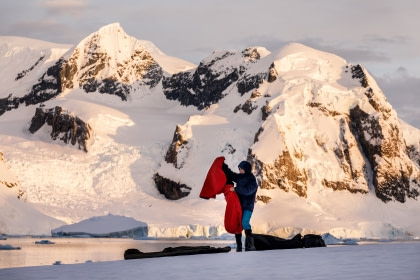
Antarctica - Basecamp - free camping, kayaking, snowshoe/hiking, mountaineering, photo workshop
HDS23-24 The Antarctic Peninsula Basecamp cruise offers you a myriad of ways to explore and enjoy the Antarctic Region. This expedition allows you to hike, snowshoe, kayak, go mountaineering, and even camp out under the Southern Polar skies.
23 Nov - 5 Dec, 2024
We have a total of 62 cruises

Wandering Albatrosses, Snowy Albatrosses or White-winged Albatrosses
The Wandering Albatrosses , Snowy Albatross , or White-winged Albatross , Diomedea exulans , is a large seabird from the family Diomedeidae which has a circumpolar range in the Southern Ocean.
It was the first species of albatross to be described and was long considered the same species as the Tristan Albatross and the Antipodean Albatross . In fact, a few authors still consider them all subspecies of the same species.
The SACC has a proposal on the table to split this species, and BirdLife International has already split it. Together with the Amsterdam Albatross , it forms the Wandering Albatross species complex.
Table of Contents
The Wandering Albatross is the largest member of the genus Diomedea (the great albatrosses ), one of the largest birds in the world, and is one of the best-known and studied species of bird in the world.

The Wandering Albatross was first described as Diomedea exulans by Carolus Linnaeus, in 1758, based on a specimen from the Cape of Good Hope.
The wandering Albatross has two sub-species as follows
- Diomedea exulans exulans
- Diomedea exulans gibsoni
The Gibsoni subspecies nests on the Azores and Marion Island.
Description
The Wandering Albatrosses has the largest wingspan of any living bird, with a wingspan between 251–350 cm (8.2–11.5 ft). The longest-winged examples verified have been about 3.7 m (12 ft), but probably apocryphal reports of as much as 5.3 m (17 ft) are known.
As a result of its wingspan, it is capable of remaining in the air without beating its wings for several hours at a time (travelling 22 m for every meter of drop). The length of the body is about 107–135 cm (3.5–4.4 ft) with females being slightly smaller than males, and they weigh typically from 6.25–11.3 kg (13.8–24.9 lb).
Immature birds have been recorded weighing as much as 16.1 kg (35 lb) during their first flights.
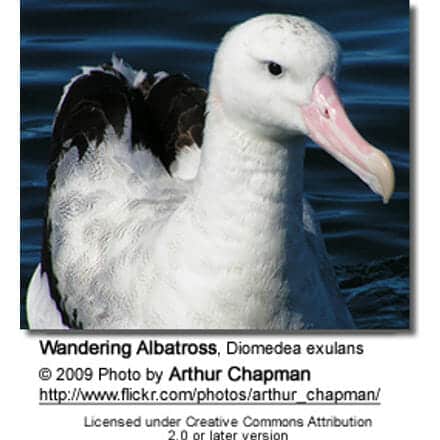
The plumage varies with age, with the juveniles starting chocolate brown. As they age they lose their color and get whiter. The adults have white bodies with black and white wings.
Males have whiter wings than females with just the tips and trailing edges of the wings black. They also show a faint peach spot on the side of the head.
The Wandering Albatrosses is the whitest of the Wandering Albatross species complex, the other species having a great deal more brown and black on the wings and body as breeding adults, very closely resembling immature Wandering Albatrosses. The large bill is pink, as are the feet.
They also have a salt gland that is situated above the nasal passage and helps desalinate their bodies, due to the high amount of ocean water that they imbibe. It excretes a high saline solution from their nose.
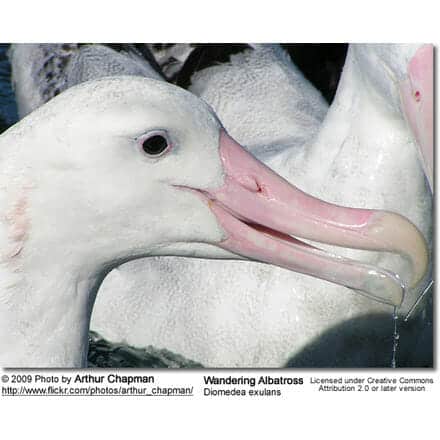
They are a group bird and have a large range of displays from screams and whistles to grunts and bill clapping. When courting they will spread their wings, wave their heads, and rap their bills together, while braying. They live for about 23 years.
They are night feeders and feed on cephalopods, small fish, and crustaceans and on animal refuse that floats on the sea, eating to such excess at times that they are unable to fly and rest helplessly on the water. They are prone to following ships for refuse. They can also make shallow dives.
Reproduction
The Wandering Albatrosses breeds every other year. At breeding time they occupy loose colonies on isolated island groups in the Southern Ocean.
They lay one egg that is white, with a few spots, and is about 10 cm (3.9 in) long. They lay this egg between 10 December and 5 January, in their nests, which is a large bowl built of grassy vegetation and soil peat, that is 1 metre wide at the base and half a metre wide at the apex.
Incubation takes about 11 weeks and both parents are involved. They are a monogamous species, usually for life. Adolescents return to the colony within 6 years; however, they won’t start breeding until 11 to 15 years. About 30% of fledglings survive.
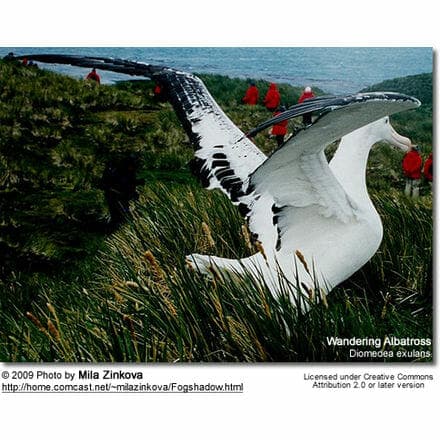
The Wandering Albatross breeds on South Georgia Island, Crozet Islands, Kerguelen Islands, Prince Edward Islands, and Macquarie Island, is seen feeding year round off the Kaikoura Peninsula on the east coast of the south island of New Zealand and it ranges in all the southern oceans from 28° to 60°.
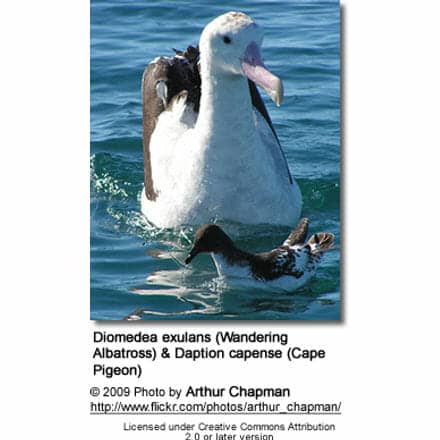
Relationship with humans
Sailors used to capture the birds for their long wing bones, which they manufactured into tobacco pipe stems. The early explorers of the great Southern Sea cheered themselves with the companionship of the albatross in their dreary solitudes, and the evil fate of him who shot with his cross-bow the “bird of good omen” is familiar to readers of Coleridge’s The Rime of the Ancient Mariner .
The metaphor of “an albatross around his neck” also comes from the poem and indicates an unwanted burden causing anxiety or hindrance.
In the days of sail, it often accompanied a ship for days, not merely following it, but wheeling in wide circles around it without ever being observed to land on the water. It continued its flight, apparently untired, in tempestuous as well as moderate weather.

Conservation
The IUCN lists the Wandering Albatross as Vulnerable status. Adult mortality is 5% to 7% per year. It has an occurrence range of 64,700,000 km2 (25,000,000 sq mi), although its breeding range is only 1,900 km2 (730 sq mi).
In 2007, there were an estimated 25,500 adult birds, broken down to 1,553 pairs on South Georgia Island, 1,850 pairs on Prince Edward Island, 1,600 on Marion Island, 2,000 on Crozet Islands, 1,100 on the Kerguelen Islands, and 12 on Macquarie Island for a total of 8,114 breeding pairs.
The South Georgia population is shrinking at 1.8% per year. The levels of birds at Prince Edward and the Crozet Islands seem to be stabilizing although most recently there may be some shrinking of the population.
The biggest threat to their survival is long-line fishing; however, pollution, mainly plastics and fishing hooks, is also taking a toll.
The CCAMLR has introduced measures to reduce the bycatch of Albatrosses around South Georgia by 99%, and other regional fishing commissions are taking similar measures to reduce fatalities. The Prince Edward Islands are a nature preserve, and the Macquarie Islands are a World Heritage site. Finally, large parts of the Crozet Islands and the Kerguelen Islands are nature preserves.

Diomedea exulans can be broken apart into Diomedea which refers to Diomedes (= a hero in Greek mythology) whose companions turned to birds, and exulans or exsul which means an exile or wanderer referring to its lonely distant flights.
- Sarus Crane – the tallest flying bird alive today
- Bustards , which contain the heaviest living flying birds
- Argentavis , the biggest flying bird ever to live
Gordon Ramel
Scolopacidae, long-billed pipits or brown rock pipits, leave a reply cancel reply.
Your email address will not be published. Required fields are marked *
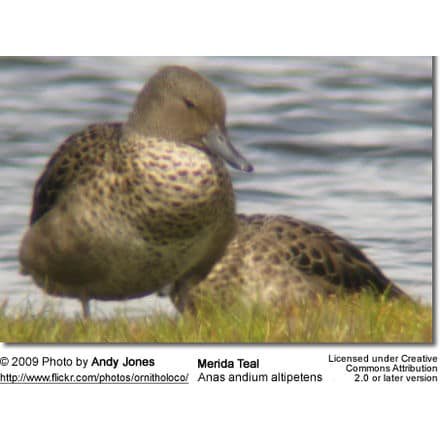
Related Articles
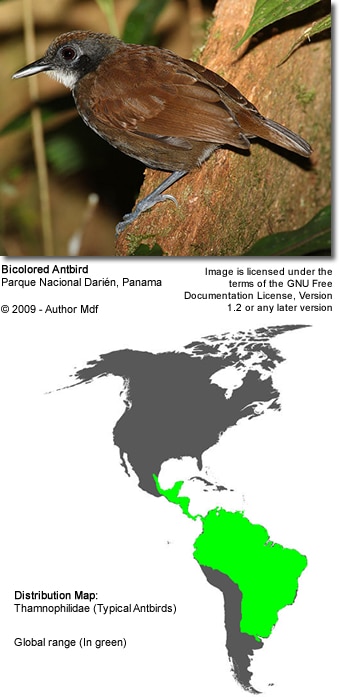
Antbirds (Thamnophilidae)
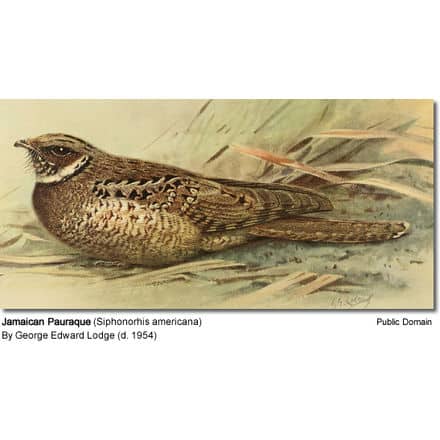
Jamaican Pauraque
Taiwan yuhinas or formosan yuhinas.

Velvet-purple Coronets
{{ searchResult.title }}
How Big Are Albatrosses? (Wingspan + Size)
Last updated: 5 February 2023
Share this article
- Albatross wingspans
- Albatross weights
- How big is the biggest albatross?
- Why are albatrosses so big?
- Albatrosses compared to other bird species
- Albatross Size FAQs
Albatrosses are some of the largest and most impressive birds in all the animal kingdom. Few birdwatchers get the chance to see these birds through their own binoculars because of their open ocean habitat and remote breeding sites, however.
Most of the world's albatrosses live and breed in the cold and windy southern oceans, although three species can be seen out over the open waters of the northern pacific.
Albatrosses are the largest flying seabirds. In fact, these majestic birds have the largest wingspan of any living bird. Scientists are still working on their classification, but there are probably about two-dozen albatross species in four genera. The largest albatross species can weigh over 26 pounds and measure well over 11 feet from wing tip to wing tip.
Albatrosses are made for the air. These birds soar low to the water surface using an energy-efficient flying method known as dynamic soaring.
They are able to fly into even strong wind without flapping by using the lift provided by their wings, their streamlined form, and the power of gravity.
This article covers the impressive size of the largest albatrosses as well as the species you are most likely to see. We’ll also learn about why these birds get so big and how they compare with other large bird species.
Albatrosses have the largest wingspan of any living bird
Albatrosses have the largest wingspans of any flying birds on the planet. When they are not breeding, these birds spend all of their lives out at sea, moving between rich fishing grounds. They use their long, narrow wings to travel incredible distances of up to 15 000 miles each month. Let that soak in for a minute!
Read on to discover the albatross species with the largest wingspans.
Wandering albatross ( Diomedea exulans ) - Up to 11 feet 6 inches (254-351cm)
The wandering albatross has the largest wingspan of any living bird. There are 5 subspecies of wandering albatross, and the snowy wandering albatross (D. e. exulans) of the Southern Ocean is the largest.
Royal albatross ( Diomedea epomophora )- Up to 11 feet 6 inches (290-351cm)
Like the wandering albatross, the royal albatross has also been split into two subspecies. The southern subspecies (D. e. epomophora) which breeds on the Campbell and Auckland islands is the larger of the two.
Short-tailed albatross ( Phoebastria albatrus ) - Up to 7 feet 10 inches (213-240 cm)
The short-tailed albatross has the largest wingspan of all the species found in the northern Pacific. These large seabirds can turn up just about anywhere offshore between the west coast of North America and Asia on the other side of the ocean.
Black-footed albatross ( Phoebastria nigripes ) - Up to 7 feet 1 inch (193-216 cm)
The black-footed albatross is the species you are most likely to see off the west coast of North America. They may be dwarfed by the wandering and royal albatross, but they are still very impressive in their own right!
Wandering Albatrosses are the biggest species of Albatross
Albatrosses are surprisingly heavy for birds that spend so much time in the air. In fact, few flying birds reach the weight of albatrosses, and those that do certainly don’t have the same incredible flying abilities!
Read on to learn which albatross species weigh the most.
Wandering albatross ( Diomedea epomophora ) - Up to 26lb 4oz (6,720 - 11,910g / 6.7 - 11.9kg)
The wandering albatross has both the largest wingspan and the greatest mass of any flying seabird. With such a great mass, these birds rely on strong winds to stay airborne, something they can do for very long periods of time.
Royal albatross ( Diomedea exulans ) - Up to 22lb 13oz (6,520 - 10,300g / 6.5 - 10.3kg)
The royal albatross is only slightly smaller than the wandering albatross, although weight varies greatly in both species. Like the wandering albatross, these heavy birds only occur in the windiest parts of the world since they can’t fly for very long in still conditions.
Short-tailed albatross ( Phoebastria albatrus ) - Up to 16lb 8oz (5,100 – 7,500g / 5.1 - 7.5kg)
The short-tailed albatross is the largest of the three species you are likely to encounter off the west coast of North America. These vulnerable sea birds are most likely to turn up off the coast of Alaska in the north.
Laysan albatross ( Phoebastria immutabilis ) - Up to 9 lbs 7 oz (2,200 - 4,300g / 2.2 - 4.3kg)
The laysan albatross is another species that can be seen off the coast of North America. This species holds the title of the world's oldest known wild bird. A female that is affectionately known as Wisdom was tagged way back in 1956 when she was probably already about 5 years old!
Coming in at an impressive second, Royal Albatrosses can reach weights of over 10kg!
The albatrosses of the Diomedea genus are the largest species by a wide margin. Originally classified as just two species, these birds have since been split into no less than 7 subspecies, with some authorities suggesting each represents its own full species.
The largest albatross species in the world is the wandering albatross ( Diomedea exulans ). These immense birds have a body length of up to 51 inches (135cm) and an incredible wingspan of 11 feet and 6 inches (351cm). Wandering albatrosses are heavy too, with large specimens weighing over 26 pounds.
Wandering Albatross on the water
Albatrosses are the largest flying seabirds. They use their massive wings to harness the power of variations in airflow above the surface of the water. This flying technique is known as dynamic soaring and it allows the birds to travel amazing distances to rich feeding grounds without even needing to flap their wings. Naturally, such large wings need a large body to support and power them.
When it comes to albatross size, diet is also a big factor. The wandering albatross feeds mostly on large species of squid like the giant warty squid ( Moroteuthopsis longimana ) and the giant cuttlefish ( Sepia apama ) that they catch from the surface or at depths of about three feet or less.
This limits competition with smaller seabirds that target smaller prey items. Size can also be a great advantage when there is competition for a shared resource. This is clear to see when the larger species dominate others around food sources.
Short-tailed albatross in flight, Japan
Albatrosses are known to be giants in the seabird world, but how do they stack up against other large bird species ? Keep reading to find out!
The African ostrich is the largest living bird species in the world . These flightless birds can grow to nearly 9 feet tall and weigh over 340 pounds. With a wingspan of just 6 feet 6 inches (2m) however, ostriches fall well short of the albatross.
The kori bustard of Africa and the great bustard of Europe and Asia take the prize for the heaviest flying birds. These massive ground birds can reach over 40 pounds, although they certainly do not have the same grace as the albatrosses!
Andean condor
The Andean condor from South America comes close to the size of the largest albatrosses. These vultures are a little heavier at up to 33 pounds (15 kilograms) and have just a slightly smaller wingspan of 10 feet 6 inches (320cm).
Trumpeter swan
The trumpeter swan is the heaviest flying bird in North America. These giant water birds have much shorter wings but are even heavier than albatrosses at just under 28 pounds.
Waved albatross (Phoebastria irrorata) in flight
Are albatross bigger than seagulls?
Albatrosses are significantly larger than seagulls. The largest gull species, the great black-backed gull of the northern Atlantic is no small bird, however.
Are albatrosses the biggest seabirds?
Albatrosses are the largest flying seabirds but they are not the only big oceanic birds. The southern and northern giant petrels can reach weights of over 12 lbs 12oz (5.8kg) and have wingspans of nearly 7 feet (2.1m). The largest seabird overall is the emperor penguin, a flightless bird that can reach an astonishing 101lbs 6oz (46kg).
What is the smallest albatross?
The mollymawks of the genus Thalassarche are the smallest albatrosses. The Atlantic yellow-nosed albatross stands out as the smallest species with a maximum weight of about 6 lbs (2.8 kg) and a wingspan of 7 feet (215cm).
Enjoyed this content? Share it now
On this page
You may also like.
Exploring the World's Largest Birds: A Size Comparison
How Big Are Frigatebirds? (Wingspan + Size)
Get the best of Birdfact
Brighten up your inbox with our exclusive newsletter , enjoyed by thousands of people from around the world.
Your information will be used in accordance with Birdfact's privacy policy . You may opt out at any time.
© 2024 - Birdfact. All rights reserved. No part of this site may be reproduced without our written permission.
- Newsletters
Home / Blog /
How do they do it the magnificent wandering albatrosses.
Author: Norm Budnitz
Consider the Wandering Albatross.
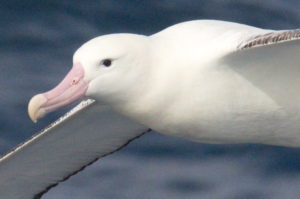
- Wingspan: up to 11 feet 6 inches (My ‘wingspan,’ fingertip to fingertip, is 5 feet 6 inches.)
- Weight: up to 28 pounds (Think about a large Thanksgiving turkey.)
- Lifespan: perhaps up to 60 years
- Travel: up to 75,000 miles per year (circumnavigating the Southern Ocean 3 times)
I have watched Wandering Albatrosses follow a ship I was on for hours without ever beating their wings. They simply fly in wide arcs, swooping downwind toward the water, then catching the updrafts off the waves and gliding upward (called dynamic soaring ). They can lock their wings in this gliding posture, so they don’t have to spend energy holding their wings out. (Try holding your arms out for just 10 minutes!) In moderate to heavy winds, albatrosses can do this for hours at a time with negligible energy costs. If there is no wind, however, they become becalmed. Hauling all that weight around becomes very expensive. But Wandering Albatrosses live in a windy part of the world, the southern oceans, so this is rarely a problem for them.
Wandering Albatrosses do have to land on the water to feed. They spot food from the air—squid, fish, crustaceans and even dead whales and seals floating at or near the surface. They rarely dive into the water, but rather settle onto the surface and pluck up their prey. To get off the water, they turn into the wind, flap their wings a couple of times, and get back into gliding mode.
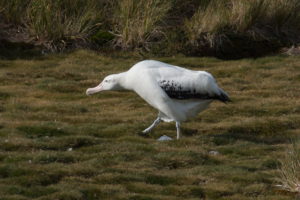
Albatrosses only come to land to breed on various islands in the southern oceans. As graceful as they are in the air, they are equally as ungraceful on terra firma. As they come in, they put down their landing gear (legs and feet) and try not to tumble over as they hit the earth. It helps that they typically nest in grassy areas, so they don’t get hurt if they do tumble. And those grassy areas are near cliffs, so that to get airborne, they simply walk to the cliff’s edge and ‘jump’ off.
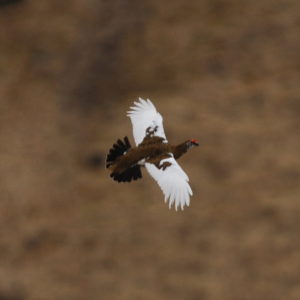
How do they do it? What are the adaptations they have gained through evolution that make it possible for them to live this amazing life in the air? First, consider the concept of wing-loading. Wing-loading is the relationship between body weight and wing surface area. The lift a bird can generate is directly related to the surface area of its wings—the more surface, the more lift. Heavy birds need to generate lots of lift in order to fly. Birds with high wing-loading, think chickens and turkeys (or the Rock Ptarmigan pictured here), tend to be very heavy and have short, stubby wings. If you have ever been startled by a Wild Turkey exploding out of the trees in front of you as you walk quietly along a forest path, you know what it’s like for a bird to have high wing-loading. Turkeys burst into the air making a huge noise, flapping their wings very rapidly, but they don’t (can’t) fly very far. That kind of flight is expensive, and their wing muscles get tired quickly. Turkeys rarely fly except when they are in escape mode.
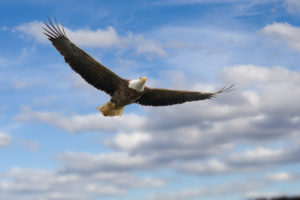
On the other hand, a Bald Eagle, though a robust bird to be sure, has very broad, wide wings. All that wing area can generate lots of lift. Thus, eagles have relatively low wing-loading, that ratio of body weight to wing area, and can generate lots of lift whether flapping or soaring.
The second concept to consider is aspect ratio, the relationship between wing length versus wing width. A wing with high aspect ratio is long and narrow. Low aspect ratio wings are about as long as they are wide. An advantage of long, narrow wings with high aspect ratio is that they have a lot of wing area for lift, but they do not generate much turbulence as they move through the air. Turbulence is a soaring bird’s worst enemy, because it decreases lift and increases drag. Thus, birds with high aspect ratio wings can soar for prolonged periods of time and still maintain their maneuverability—i.e., turn on a dime. Turkeys and ptarmigans, with low aspect ratio wings, create lots of turbulence, creating all that wing flapping noise, and basically just fly fast and straight to escape from a possible predator.
Where do our albatrosses fit into this scheme of things? They are quite heavy-bodied birds, so they have high wing-loading. But they also have high aspect ratio wings, in the extreme. This makes up for the high wing-loading, so they can soar for hours and still be maneuverable when they need to be.
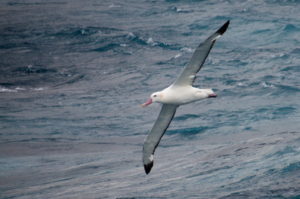
It is hard for humans to envision the weeks, months, even years that Wandering Albatrosses spend at sea. But think of it from the albatross’s point of view: What are those strange creatures who spend all their time stuck fast to the land? Occasionally they go up in one of those metal fixed-wing monsters with high wing-loading. It must be rather difficult to find a squid from one of those things, let alone drop down and pluck it from the water’s surface for a tasty meal.
I bet the albatrosses prefer being albatrosses. Even if it means they have to drink seawater when they are thirsty. But that’s another story.
Some of the information in this article was plucked from these sources: Dereck Onley and Paul Scofield, Albatrosses, Petrels, and Shearwaters of the World. David Allen Sibley, The Sibley Guide to Bird Life & Behavior. Wikipedia article on Wandering Albatross .
Photographs by Norm Budnitz except the Bald Eagle by Bill Majoros.
Stay In Touch
’Like’ our Facebook Page to see announcements; join our Facebook Group to share photos, events, and questions; follow us on Instagram; get email announcements of our activities; join our Meetup Group. Pick your service(s) and never miss out on New Hope Audubon news!
Copyright © 2023 New Hope Audubon Society

Meet the Largest Flying Bird in the World: The Wandering Albatross
Published: July 15, 2023
The animal kingdom is filled with diverse incredible creatures, each with unique characteristics and abilities. Among them, the wandering albatross stands out as one of the most fascinating birds on the planet. With a wingspan of over three meters, it proudly holds the title of the largest flying bird in the world. These majestic creatures are known for their long-distance flights over the open ocean and remarkable resilience in surviving harsh weather conditions. Get ready to be amazed by this remarkable bird’s incredible abilities and features!
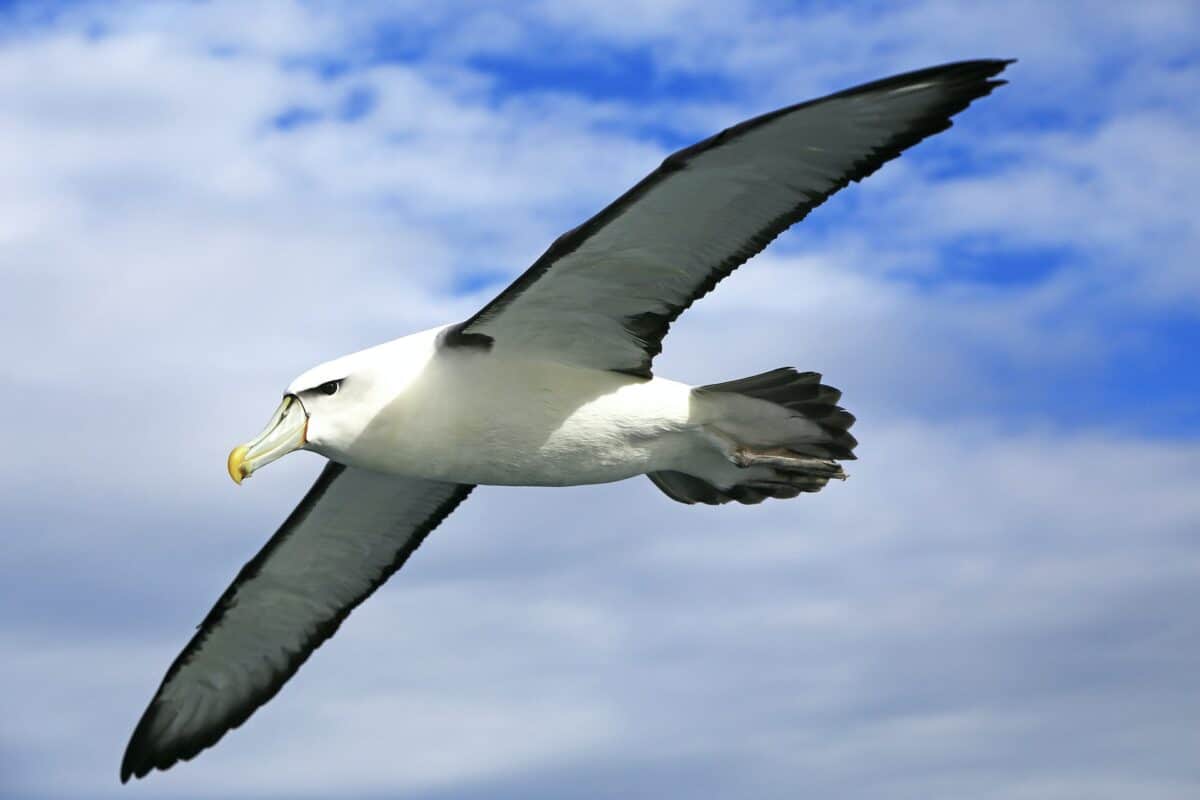
Soar to any section below!
Physical Characteristics
The wandering albatross can span over three meters, making it the largest flying bird in the world. This feature sets the wandering albatross apart from all other birds, giving it a unique and majestic appearance. As for their weight, albatrosses are relatively light despite their size, weighing in at around 7-11 kilograms.
The wandering albatross’s wingspan is a marvel of nature. Its wings are incredibly long and broad, specifically suited to gliding over long distances. Although they may look cumbersome, these wings are perfectly designed to give the bird maximum lift while minimizing drag during flight. This allows the wandering albatross to fly great distances without too much energy.

Feather Colors
The wandering albatross is mainly white, with black feathers on its back and wings. The color of its feathers gives the wandering albatross a striking appearance and serves a practical purpose. The white feathers help the bird blend with its surroundings, making it less visible to potential predators. On the other hand, the black feathers on its back help absorb heat, which is important when flying over the open ocean.
The wandering albatross’ beak is distinctive, with a hooked shape perfectly suited to its diet. These birds are primarily scavengers and will eat anything from squid to fish, with the occasional seal carcass thrown in. Their hooked beak helps them rip apart tough materials, such as fish skin, which they swallow whole.
Check out: Unearth the Reality of Georgia’s Brown Recluse Spiders .
Behavior And Lifestyle Of The Wandering Albatross

The wandering albatross is not just a remarkable bird because of its physical characteristics, it also showcases fascinating behaviors that have captivated researchers and bird enthusiasts alike. In this section, we delve into the distinct behaviors of the wandering albatross, including its breeding habits, migration patterns, hunting techniques, and socialization within flocks.
Breeding Habits
Breeding is a crucial part of the wandering albatross’s life cycle, and they typically breed on remote sub-Antarctic islands. These islands provide a haven for the birds to mate and rear their young without the threat of predators. Breeding pairs will mate for life; every breeding season, they will mate and produce a single egg that they take turns incubating. During incubation, the male and female albatrosses stay in the nest to keep the egg warm. Once the egg hatches, the parents feed the chick, regurgitating food from their stomachs to feed their young.

Migration Patterns
One of the most unusual behaviors of the wandering albatross is its long-distance migration patterns. These birds can fly thousands of kilometers over the open ocean, often without resting, for months. The albatrosses do this to find food, as their main source of nutrition is squid and fish, which they hunt in the open ocean. The wandering albatross also has a unique way of navigating their migrations. They use the Earth’s magnetic field as a guide, using their ability to sense the Earth’s magnetic field to orient themselves and navigate their journeys.
Hunting Techniques
When it comes to hunting, the wandering albatross has developed unique techniques that allow them to thrive in the harsh and challenging conditions of open ocean hunting. They use their incredible eyesight and sense of smell to locate squid and fish in the water. Once they spot their prey, they use their long, powerful wings to fly just above the water’s surface, dipping their beaks into the water to snatch up their meal.
Check out: Surviving the Realm of Tiger Snake Bites .
Socialization Within Flocks
The wandering albatross is a highly social bird, often forming large flocks when not breeding. These flocks provide safety and companionship for the birds while on their long journeys. They also perform elaborate courtship rituals within these flocks, using intricate dance moves and calls to attract potential mates.
Check out: Lost Cat’s Remarkable Cross-Country Journey Home .
Conservation Status Of The Wandering Albatross
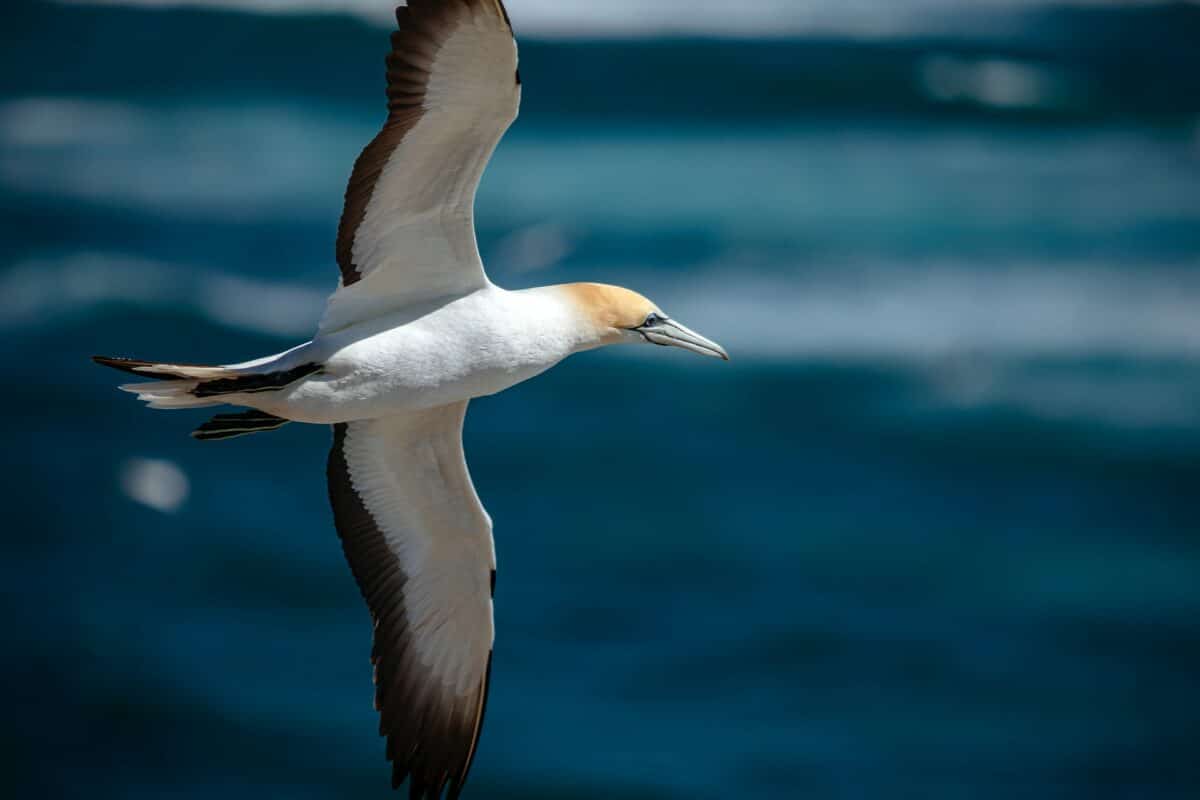
The wandering albatross is undoubtedly one of the most striking birds on the planet. Unfortunately, it is one of the most vulnerable species and is listed as “endangered” under the IUCN Red List , meaning it is at risk of extinction. The wandering albatross faces numerous threats to its population, including climate change, habitat loss, and human activities such as fishing, pollution, and plastic waste.
Threats To Wandering Albatross Population
Climate change has caused a significant impact on the wandering albatross population. Changes in water temperature and ice cover affect the bird’s food supply, which can result in lower breeding success rates. The increase in plastic waste has also led to many albatrosses suffering entanglement and ingestion of plastic debris, resulting in death. The longline fishing industry is another serious threat to their population, with these birds accidentally killed by fishing hooks and nets.
Conservation Efforts
Several conservation efforts have been implemented to combat these threats to the wandering albatross population. The Agreement on the Conservation of Albatrosses and Petrels (ACAP) is an international agreement aimed to conserve albatross and petrel species and reduce the impact of harmful fishing practices.
The ACAP framework has implemented measures such as using bird-scaring streamers and setting longline fishing at night to avoid seabirds. There are also efforts to reduce plastic pollution through cleanup projects and recycling campaigns.
Success Stories
Despite the threats, there are some success stories. For example, in Macquarie Island, a designated United Nations Educational, Scientific, and Cultural Organization ( UNESCO ) World Heritage Site, the wandering albatross population is thriving due to strict conservation measures, including removing introduced animals such as rats and rabbits, which prey on the bird’s eggs and chicks.
Further efforts have led to the reduction of bird deaths due to fishing hooks. In South Africa, using small circle hooks has reduced the number of albatrosses caught in fishing gear by over 90%. These hooks do not harm the birds and can be easily removed if caught.
The wingspan of a Wandering Albatross can reach up to 11 feet, the largest of any bird in the world.
Wandering Albatross mainly feeds on fish and squid and can travel up to 600 miles daily to find food.
Wandering Albatross can live for up to 50 years and are known for their lifelong monogamous breeding pairs and unique courtship rituals.

The wandering albatross is an extraordinary bird that continues to capture the hearts and minds of scientists, birdwatchers, and nature enthusiasts worldwide. Its remarkable wingspan, ability to fly long distances over the open ocean, and resilience in harsh weather conditions are just a few qualities that set this bird apart from its peers. It’s no wonder that the wandering albatross is the world’s largest flying bird. With all its fantastic abilities and characteristics, it’s an animal kingdom marvel that deserves all the admiration and respect it gets.
Thanks for reading along! See below for related article links.
- Great White Shark Vs. Bull Shark
- The World’s Largest Land Predator: The Polar Bear
- Gorilla Vs. African Forest Buffalo
- Unveiling The Longest Snake In the World
- Discover Pennsylvania’s Hidden Threat: The Timber Rattlesnake
- Latest Posts
- Cute Dogs Sliding Down Slide At Daycare - April 20, 2024
- Mama Bear Refuses to Abandon Her Cubs - April 20, 2024
- Watch German Shepard Pretends To Be Asleep To Get Out Of Bath Time - April 19, 2024
- Find an Expedition
- Voyage Calendar
- Travel Advisors
- Manage My Booking
- Call Now: +1-833-826-5828

Wandering Albatross Facts & Information
Home > Blog > Antarctica > Wandering Albatross Facts & Information
Last updated on November 27 th , 2019
Standing on the deck of the Greg Mortimer in Antarctica , there’s a good chance that you’ll experience bracing polar winds that are powerful, bitterly cold and unrelenting. While it might be hard for you to stand up straight, these winds are perfect for one of region’s most impressive birds – the wandering albatross.
In this latest wildlife fact file, we’ll give you insight into the life of wandering albatrosses and where you can see them with Aurora Expeditions.
Kings (and queens) of the sky
As their name suggests, wandering albatross spend the bulk of their lives at sea – namely the South Pacific and Southern Oceans. Wandering albatross have the largest wingspan of any bird (up to 3.5m) allowing them to pursue long fishing trips of 10-20 days covering up to 10,000km at a time. The birds will continuously take to the skies for food, soaring above heavy seas and through strong winds for thousands of kilometres to find fish, squid and crustaceans.
A post shared by Jack Shick (@jackshick_lhiphotography) on Jul 31, 2017 at 2:07pm PDT
Read more: Naturist vs naturalist: What’s the difference?
To cover this sort of distance in this timeframe, the birds need both a large wingspan and a clever tactical playbook. Wandering albatross use the energy of the wind and height to soar into the conditions and leverage power allowing them to fly across Antarctica with ease.
Although their large wingspan will be the main difference that you can look for in the sky, wandering albatrosses also have a number of other unique identification markers. This includes a white body with black colouring on the wings and a pinkish-salmon coloured bill.
Giant chicks and breeding season
During breeding season (December and January), the adult birds return to their colonies on the various sub-Antarctic islands including South Georgia, Prince Edwards Island, Crozet and Kerguelan Islands.
A post shared by Melanie Wells (@mellywelly2) on Sep 3, 2017 at 7:31am PDT
Read more: Spitsbergen birdlife to spot on your Arctic expedition
A breeding pair of wandering albatross mate for life and usually produce one chick every two years. Once on land, the female will nest on an exposed ridge or cliff, protecting the egg with a nest surrounded by vegetation and mud. The parents will then take turns to look after the egg during the incubation period.
Around 11 weeks later, the sub-Antarctic islands will be packed with hungry, giant wandering albatross chicks. With parents that can weigh up to 13kg, chicks emerge well-developed in size which can be a handful for mum and dad! After just 12 months, the chicks (weighing around 12kg) will leave the nest and start their own breeding cycle.
If you’re lucky enough to visit a wandering albatross breeding site, you’ll no doubt hear a high-pitched trumpeting call as well as a number of other sounds including groans and rattles. Interestingly, wandering albatross are silent at sea – in stark contrast to other Antarctic seabirds such as gulls and mollymawks.
A post shared by Alana Jackson (@elsabordeaux) on Sep 5, 2017 at 2:27pm PDT
Read more: When is the best time to go to Antarctica?
Population and conservation
Wandering albatrosses are regarded as “vulnerable” with the world population estimated at around 26,000 individual birds. Although the species breed on well-protected islands free of predators, wandering albatrosses are known to be caught in longlines out at sea.
Combine this fact with the unusual two-year breeding cycle and the population is slow to recover from losses. There is a sustained effort from fishing ships in the Southern Ocean to use equipment that all seabirds including wandering albatrosses can’t get caught in.
Do you want to see a wandering albatross in full-flight?
There aren’t too many birds that match the wandering albatross for size, power and precision flying. As such, it always special to see this species in full-flight ducking and diving above the rough ocean.
If you would like the opportunity to see wandering albatrosses, we have range of Antarctic tours where we venture into their territory. For more information, get in touch with the expert team at Aurora Expeditions today.
You may also like
Late season antarctica: why i like antarctic trips in march.
It’s fantastic – you have the real Antarctica, and you have it all to yourself. Dr. Roger Kirkwood March is …
How cold is Antarctica?
Antarctica is the coldest place on earth. Colder than the Arctic and the Andes, even colder than the summit of …
Is Antarctica a desert? YES. Find out why
When most people imagine Antarctica they think of a cold continent covered in ice. And they’re right. In fact, 90% …
Do people live in Antarctica?
Antarctica is known for being the highest, driest, coldest and windiest continent on earth. So perhaps it won’t come as …
Request a customised quote
Privacy Overview
Wandering Albatross (Diomedea exulans)
The Wandering Albatross (Diomedea exulans) also known as the snowy albatross, is a seabird with white plumage. Wandering albatrosses have the largest wingspan of any bird ranging from 98”-138” (250–350 cm). They can be found in all oceans except for the Atlantic Ocean. They spend most of their lives in flight and almost have no natural predators. Some have been known to circumnavigate the Southern Ocean. Wandering albatrosses make shallow dives to feed on cephalopods, small fish, and crustaceans. Wandering albatrosses are considered vulnerable to extinction.
The Wandering Albatross has a wingspan in the range of 98”-138” (250–350 cm) and total weight of 13-28 lb (5.9-12.7 kg). The body of the Wandering Albatross has an overall length between 42.1”-53.1” (107-135 cm), body width of 16.3”-20.5” (41.5-52 cm), and standing height of roughly 39.4”-49.6” (100-126 cm). The typical lifespan of the Wandering Albatross is between 50-80 years.
*Under Development*
Body Width: 16.3”-20.5” | 41.5-52 cm
Drawings include: Wandering Albatross side view, front, flying (assorted)
Wikipedia - Wandering Albatross
Wikipedia - Seabird
2D Downloads
3d downloads.
Seabirds are a species of bird that spends most of its life in marine habitats. Seabirds generally live longer, breed later, and have fewer young than other birds. Seabirds also tend to nest in colonies and have extraordinarily long migrations, sometimes across the equator or around the world.

Wandering Albatross Size: Explained and Compared In Detail
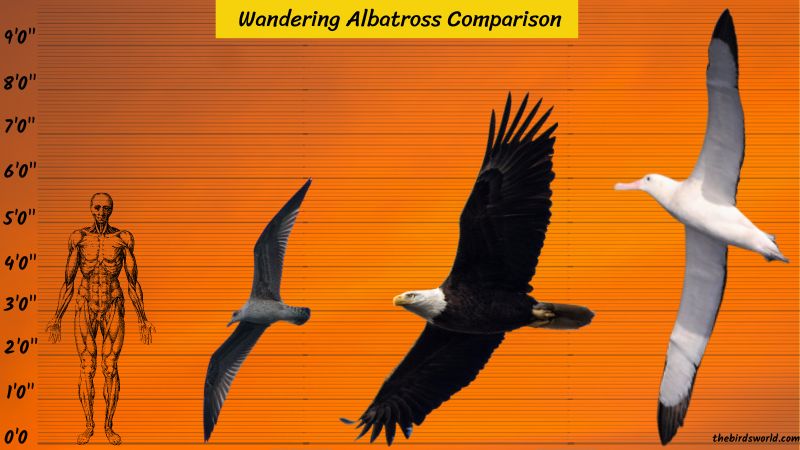
If you ever find yourself pacing through the Atlantic Ocean, just look up and you will almost surely find yourself gazing at the underside of the star of our show today, the wandering albatross!
Known for being one of the best gliders on the animal planet, these birds have an impressively long list of attributes that have been the primary subject for scientists all over.
Doubly curious and fascinating, they also stand out with their incredible size and more prominently, their insane wingspan.
And so today we are going to take an in-depth look at everything you need to know about this fascinating Wandering Albatross Size!
Without further ado, let us dive right in!
Wandering Albatross Length
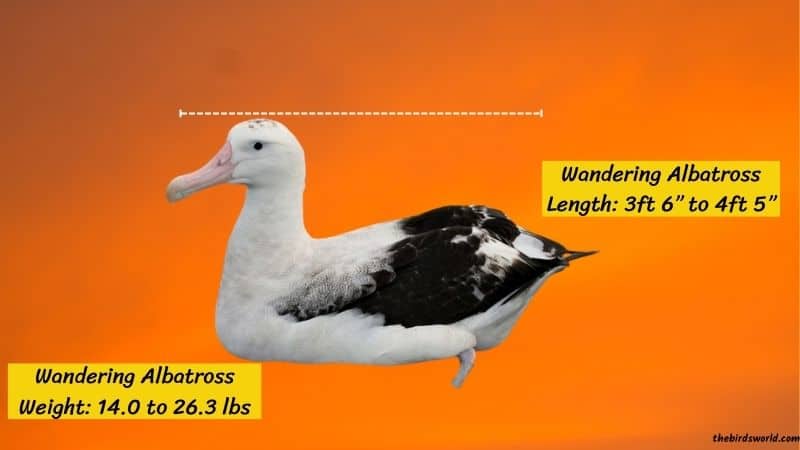
One crucial and fascinating aspect of their size is their stocky build and stature, which their considerable heights add to.
Females are generally slightly smaller than males, and males stand about an average of 4 feet.
Females, on the other hand, stand just a few inches short of their male counterparts, at about an average of 3.75 inches.
This impressive stature combined with their white and gray plumage gives them a stark but elegant look and also helps them camouflage well with their white surroundings.
Wandering Albatross Weight
An obvious thing to look at when measuring their size is their weight.
Albatrosses are known to be pretty hefty as is, as they need quite a lot of fat deposits to make it through the harsh conditions they are often under.
Did you also know that albatrosses can go for years without touching land in between? That’s right! And so they need all the energy they can get through their food.
Adult males usually weigh in at an average of 22 pounds while females weigh in slightly below that at an average of 19 pounds.
When averages were taken across its far-reaching range, most species from Crozet and Macquarie Islands averaged similar numbers at about 20 pounds.
Wandering Albatross Wingspan
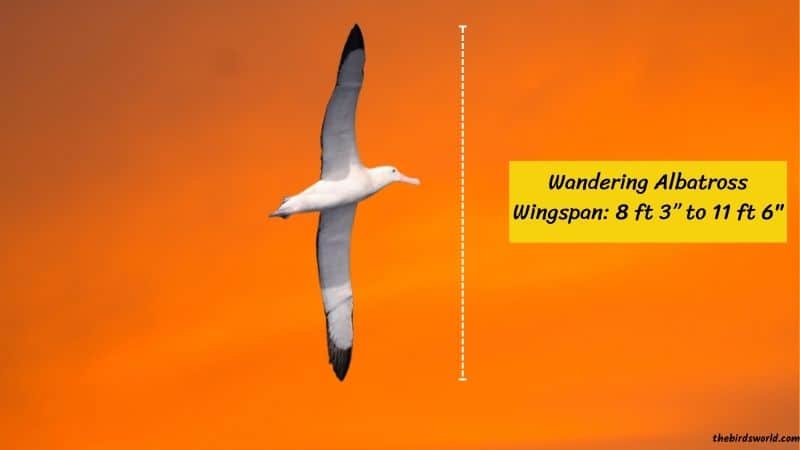
Onto the most impressive of features, their insane wingspans!
Most adult Wandering Albatross average an insane length of about 9 feet 5 inches with their wingspans, with extraordinary numbers going up to 14 feet also being reported in many cases, though these remain unverified.
The largest wingspan to date is reported at 12 feet 2 inches, which is more than twice the length of an average human being!
This incredible wingspan also enables them to stay afloat for long periods of time with seemingly no difficulty. They trust their wingspans so much, in fact, that they even sleep while airborne.
How Big Are Wandering Albatross Babies?
Wandering albatross babies are generally called “chicks”, and have no specific word to call them.
Chicks are usually born covered in down feathers from the neck down and weigh just about a few punches and measure in at about 12 inches.
These babies then gradually develop the characteristic juvenile plumage that is slightly darker.
Chicks remain completely dependent on their parents for the first 6 months of their life, after which they slowly get on their own feet.
Wandering Albatross Size Compared To Humans?
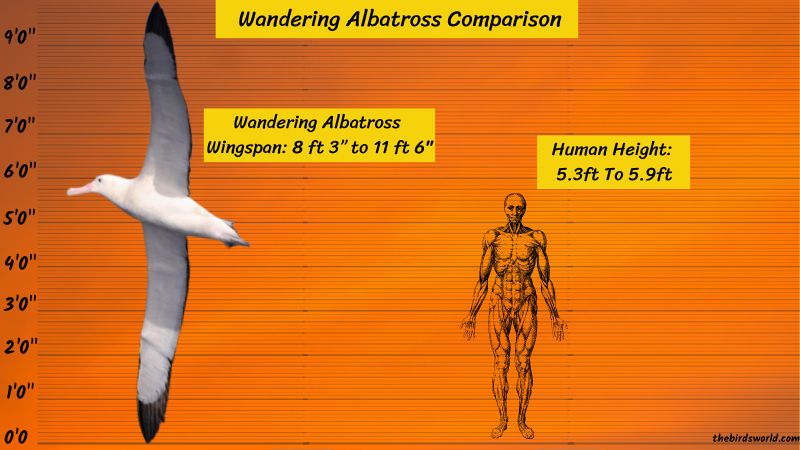
Of course, we must also talk of perspectives when we talk of size, so it is only just that we start this comparison off with our own species, however obvious the answer may be. The average wandering albatross is only about 4.5 feet in length and weighs about 19 pounds.
Here the average adult human being stands tall with their 5 feet 9 inches stance. But lay the albatross on its side and look at its wingspan though, we quickly become dwarfed by the 11 feet distance, almost double our length!
Wandering Albatross Size Compared To Andean Condors
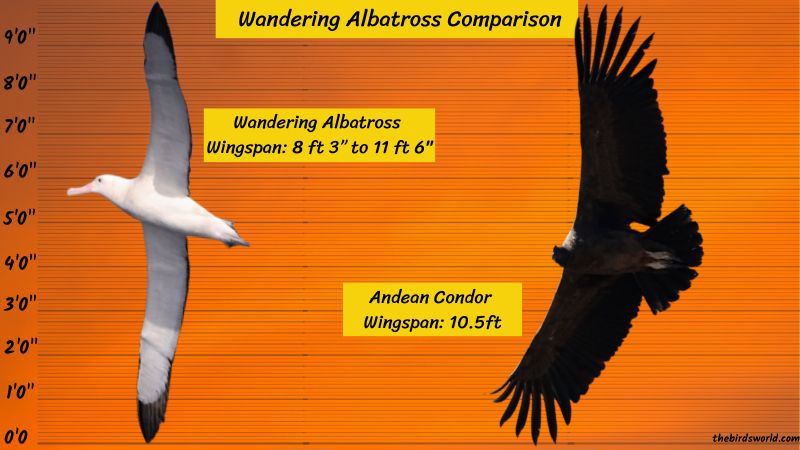
The Andean Condor is a similarly large bird, belonging to the genus Vultur.
Endemic to the Pacific coasts of western South America, they are particularly scary birds because of their pointed faces, and the ruffle of feathers at the crown of their heads.
They are also similar in both length and weight, with the condor averaging 3ft 9 inches as their length, and about 25 lbs mean weight. The wandering albatross stands only slightly taller but weighs pretty much the same.
Wandering Albatross Size Compared To Eagles
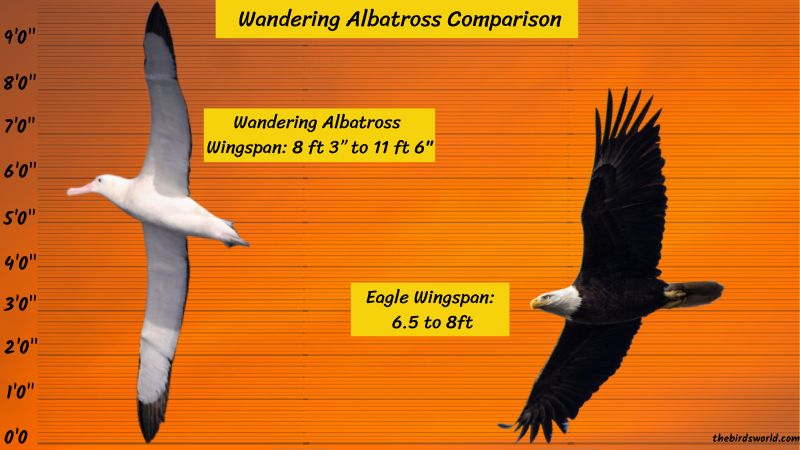
Moving on to yet another bird of prey, a most famous one known for its mighty soaring and incredible wingspan, we have the eagle!
As mighty and majestic as these birds might be though, they don’t hold a candle to the immense size of the wandering albatross.
The wandering albatross stands a few good feet above them in stature and weigh about double their average weight.
And as impressive and mystifying as eagle wingspans might be, the albatross takes the medal here as well, with its 10 feet wingspan!
Wandering Albatross Size Compared To Seagulls
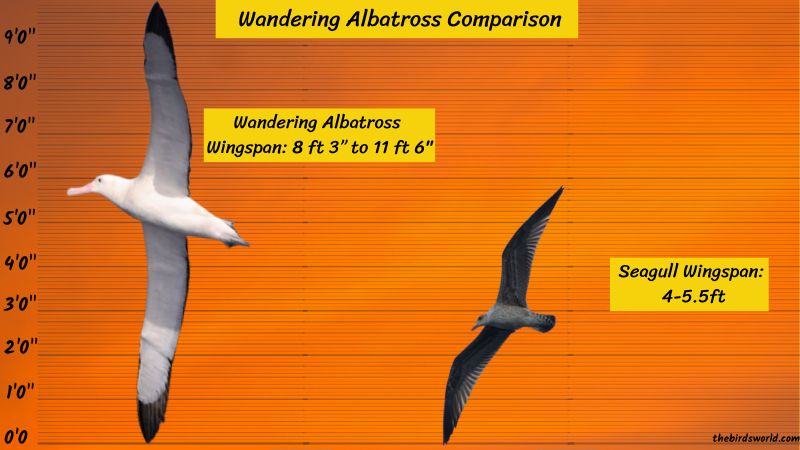
Changing paces a little bit, let us now look at a similarly coast-dwelling bird, and the most infamous of them all, the seagull.
Mostly known for their imperious pecking and their squawk calls, these birds are a staple on any family vacation and surprisingly familiar sight.
Yet again though, when looking at sizes, the wandering albatross takes the cake. The seagull goes up to only lengths of about 30 inches on average, weighing in at a meager 3 lbs.
They also have a limited wingspan of about 49-66 inches which obviously sits nowhere near the immense 10 feet wing size of the wandering albatross!
In Conclusion
And that was all you needed to know about wandering albatrosses and their sizes. Though they are widely researched and are a constant source of information for scientists, we hardly think of them when we think of birds of Antarctica.
We hope you had a fun time venturing into this vast and wonderful world with us, and that you learned something new today!
Thank you for reading!
Related Articles You May Like
- Emu Feet Size & Power
- Cassowary Eggs Size & Comparison
- Emu Eggs Size & Comparison
- Harpy Eagle Wingspan: How Does It Compare With Others?
Comments are closed.
Type above and press Enter to search. Press Esc to cancel.

The Unbelievable Size of an Albatross’ Wingspan
Albatrosses are known for their impressive wingspan, which is the largest of any bird. The wingspan of an albatross can range from 6 to 11 feet, depending on the species.

The albatross’s wingspan is so large that it allows the bird to glide effortlessly over the ocean for hours at a time without flapping its wings.
Understanding albatross wingspan is important because it is a key factor in the bird’s ability to fly long distances over the ocean.
The wingspan of an albatross is also an important characteristic that helps scientists identify different species of albatross.
In addition, the wingspan of an albatross can provide insights into the bird’s evolutionary history and how it has adapted to life on the open ocean.
Table of Contents
Understanding Albatross Wingspans

Albatrosses are known for their impressive wingspan, which is the distance between the tips of their wings when fully extended.
The wingspan of albatrosses can range from 6.5 feet (2 meters) to an astounding 11.5 feet (3.5 meters).
The wingspan of the albatross is an important factor in its ability to fly long distances over the ocean.
With their wingspan, they are able to soar effortlessly for hours, covering great distances without flapping their wings. This makes them one of the most efficient flyers in the bird world.
The wingspan of the albatross is also one of the largest in the world, making them the largest flying bird in the world.
The wandering albatross, for example, has a wingspan of up to 11.5 feet (3.5 meters), which is the largest wingspan of any bird.
The size of the wingspan of the albatross is not only important for their flight, but also for their survival.
With their wingspan, they are able to cover a large area of the ocean in search of food. They can travel thousands of miles in search of squid , fish, and other prey.
Albatross Species

Albatrosses are a group of seabirds that belong to the family Diomedeidae. They are known for their impressive wingspan, with some species having the largest wingspan of any bird.
There are 22 species of albatross, which are divided into four genera: Diomedea, Phoebastria, Thalassarche, and Phoebetria.
Great Albatrosses
The great albatrosses are the largest of the albatross species, with wingspans that can exceed 11 feet.
They are found in the southern ocean, where they feed on squid and fish. There are three species of great albatross: the wandering albatross, the royal albatross, and the southern royal albatross.
The wandering albatross is the largest of the three, with a wingspan that can reach up to 12 feet.
Mollymawks are a group of medium-sized albatrosses that are found in the southern ocean. They have wingspans that range from 6 to 8 feet.
There are several species of mollymawks, including the black-browed albatross, the Campbell albatross, and the grey-headed albatross.
North Pacific Albatrosses
The North Pacific albatrosses are a group of four species of albatross that are found in the North Pacific Ocean .
They have wingspans that range from 6 to 7 feet. The species include the Laysan albatross, the black-footed albatross, the short-tailed albatross, and the northern royal albatross.
Sooty Albatrosses
The sooty albatrosses are a group of medium-sized albatrosses that are found in the southern ocean.
They have wingspans that range from 6 to 7 feet. There are two species of sooty albatross: the dark-mantled sooty albatross and the light-mantled sooty albatross.
There are also several subspecies of albatross, including the Antipodean albatross and the Amsterdam albatross.
Each species and subspecies of albatross has its own unique characteristics and behaviors, making them a fascinating group of birds to study.
Scientific Classification and Evolution

Albatrosses belong to the family Diomedeidae, which is part of the order Procellariiformes.
This group also includes petrels and shearwaters. The scientific name for the albatross genus is Diomedea, while the scientific name for the Laysan albatross is Phoebastria immutabilis.
The first albatross fossils date back to the Eocene epoch, around 35 million years ago. These fossils were found in South Carolina, USA , and suggest that albatrosses evolved from a group of seabirds known as the Protodontopterygidae.
The taxonomy of albatrosses has been a subject of debate among scientists for many years. In the past, all albatross species were classified under the genus Diomedea.
However, recent genetic studies have shown that the genus is not monophyletic, meaning that it does not include all of the descendants of a common ancestor.
As a result, some albatross species have been moved to new genera, such as Thalassarche and Phoebastria.
Carl Linnaeus, the famous Swedish botanist and zoologist, first described the wandering albatross (Diomedea exulans) in 1758. Since then, many new albatross species have been discovered and described.
There are currently 22 recognized species of albatross, including the Laysan albatross and the wandering albatross.
Albatrosses are known for their impressive wingspan, which is the longest of any bird. The wingspan of the wandering albatross can reach up to 3.5 meters (11 feet), while the wingspan of the Laysan albatross is around 2.1 meters (7 feet).
The large wingspan of albatrosses allows them to fly long distances over the open ocean, where they spend most of their lives.
Frequently Asked Questions
What is the wingspan of the wandering albatross.
The wandering albatross has the largest wingspan of any bird, with a range of 2.5 to 3.5 meters (8.2 to 11.5 feet) [1] . The wingspan of females is generally larger than that of males.
How does the wingspan of the albatross compare to other birds?
The wingspan of the albatross is among the largest of any bird. The wandering albatross has the largest wingspan of any bird, followed closely by the southern royal albatross and the northern royal albatross [1] .
What is the average weight of an albatross?
The weight of an albatross varies depending on the species. The wandering albatross, for example, can weigh up to 12 kilograms (26 pounds) [2] . Other species, such as the black-browed albatross, weigh significantly less, with an average weight of around 2.5 kilograms (5.5 pounds) [3] .
How long can an albatross fly without stopping?
Albatrosses are known for their impressive flying abilities and can fly for long periods without stopping. The exact amount of time an albatross can fly without stopping varies depending on the species and individual bird. Some albatrosses have been known to fly non-stop for several weeks, covering thousands of kilometers [4] .
What is the typical lifespan of an albatross?
The lifespan of an albatross varies depending on the species. Some species, such as the wandering albatross, can live for up to 50 years or more [1] . Other species, such as the black-browed albatross, have a shorter lifespan of around 30 years [3] .
What are the different types of albatross and their wingspans?
There are 22 species of albatross, each with a unique wingspan. The wandering albatross has the largest wingspan of any bird, followed by the southern royal albatross and the northern royal albatross. Other species, such as the black-browed albatross and the grey-headed albatross, have smaller wingspans [1] .
Add comment
Cancel reply.
Save my name, email, and website in this browser for the next time I comment.
You may also like

What’s the Difference Between a Heron and an Egret?

The Difference Between Egrets and Herons

What Do Seagulls Eat?

How Long Do Seagulls Live?

What’s the Difference Between an Albatross and a Seagull?

Types of Seabirds From Around the World
Latest articles.
- What’s the Difference Between Seaweed and Seagrass?
- Hilarious Video Shows How Dolphins Use Pufferfish to Get High!
- The Tallest Bridge Ever Built: A Marvel of Modern Engineering
- Are There Sharks in the North Sea?
- The Largest Lake in the World Isn’t What You Think
- Are There Sharks in Lake Washington?
About American Oceans
The American Oceans Campaign is dedicated primarily to the restoration, protection, and preservation of the health and vitality of coastal waters, estuaries, bays, wetlands, and oceans. Have a question? Contact us today.
Explore Marine Life
- Cephalopods
- Invertebrates
- Marine Mammals
- Sea Turtles & Reptiles
- Sharks & Rays
- Shellfish & Crustaceans
Copyright © 2024. Privacy Policy . Terms & Conditions . American Oceans
- Ocean Facts

IMAGES
VIDEO
COMMENTS
Length. 107-135. cm inch. Wingspan. 2.5-3.5. m ft. Described as "The bird which made the breeze to blow" the wingspan of a Wandering albatross ( Diomedea exulans) is the longest of any bird. It lives up to its name when it takes fishing trips that last 10-20 days and can cover 10,000 km while using hardly more energy than when sitting on its nest.
The Wandering albatross might be the most wide-ranging of all foraging sea birds, and maybe of all animals. They've been tracked over 15,000 km in a single foraging trip, capable of speeds of up to 80 kmph and distances of over 900 km per day. 1. 2. They're monogamous (mostly)
An albatross aloft can be a spectacular sight. These feathered giants have the longest wingspan of any bird—up to 11 feet! The wandering albatross is the biggest of some two dozen different species.
The albatross uses this deflection to gain height, and then it can glide back down to the sea. Aside from making use of different soaring techniques, the albatrosses wing also has a shoulder-lock, which is a sheet of tendon that locks the wing when fully extended. ... The wandering albatross has the largest wingspan of all extant birds. Acidic ...
This species of albatross has white plumage, or feathers, with darker wings. Their wing feathers are black, and speckled with varying degrees of white. Young birds have brown feathers, which become white as they age. This bird's wingspan is quite large, and averages 10 feet across, though some individuals are larger.
A wandering albatross has the largest wingspan of any bird, 3.5 meters (11.5 feet) tip to wing tip.
The wandering albatross can only dive about 2 to 3 feet (0.6 to 1 m) into the ocean, yet based on an analysis of its diet, scientists are pretty sure the wandering albatross eats squid that live ...
Known for its majestic wingspan and far-ranging travels, the Wandering Albatross is a captivating presence in the Southern Ocean's expanse. As the bird with the widest wingspan globally, this remarkable creature glides effortlessly across vast oceanic distances, its brilliant white plumage and solitary habits making it a unique symbol of the wild, open sea.
The snowy albatross boasts a wingspan that can exceed 3.5 meters (11 feet), with an average span of around 3.1 meters (10 feet 2 inches). Body length ranges from 107 to 135 cm (3 feet 6 inches to 4 feet 5 inches), with females being slightly smaller than males. Adults typically weigh between 5.9 to 12.7 kg (13 to 28 lb).
The Wandering Albatross is the largest of the albatrosses and is the living bird with the greatest wingspan, measuring almost 3.5 m. ... Pardalotes generally feed in the canopies of tall eucalypts, making them difficult to see. Discover more. White-fronted Tern.
These remarkably efficient gliders, named after the Greek hero Diomedes, have the largest wingspan of any bird on the planet. Name: Wandering Albatross, Snowy Albatross, White-winged Albatross ( Diomedea exulans) Length: Up to 135 cm. Weight: 6 to 12kg. Location: All oceans except in the North Atlantic.
wandering albatross facts - Basics. Average Weight: 5.9 to 12.7 kg, commonly 6.4 - 11.9 kg, males are typically around 20% heavier than females. Immature birds have been reported at up to 16.1 kg shortly after leaving the nest due to still having fat reserves that sustained while on the nest waiting for the adults to return.
Description. The Wandering Albatrosses has the largest wingspan of any living bird, with a wingspan between 251-350 cm (8.2-11.5 ft). The longest-winged examples verified have been about 3.7 m (12 ft), but probably apocryphal reports of as much as 5.3 m (17 ft) are known. As a result of its wingspan, it is capable of remaining in the air ...
The great albatrosses (i.e., wandering albatross) take over a year to raise a chick from laying to fledging. Albatrosses lay a single subelliptical ... Tall structures such as traffic control and radio towers killed 3000 birds in flight collisions during 1964-1965 before the towers were taken down.
The largest albatross species in the world is the wandering albatross (Diomedea exulans). These immense birds have a body length of up to 51 inches (135cm) and an incredible wingspan of 11 feet and 6 inches (351cm). Wandering albatrosses are heavy too, with large specimens weighing over 26 pounds. Wandering Albatross on the water.
Consider the Wandering Albatross. Wandering Albatross. Wingspan: up to 11 feet 6 inches (My 'wingspan,' fingertip to fingertip, is 5 feet 6 inches.) Weight: up to 28 pounds (Think about a large Thanksgiving turkey.) Lifespan: perhaps up to 60 years;
The wandering albatross can span over three meters, making it the largest flying bird in the world. This feature sets the wandering albatross apart from all other birds, giving it a unique and majestic appearance. As for their weight, albatrosses are relatively light despite their size, weighing in at around 7-11 kilograms. Wingspan
Wandering albatross use the energy of the wind and height to soar into the conditions and leverage power allowing them to fly across Antarctica with ease. Although their large wingspan will be the main difference that you can look for in the sky, wandering albatrosses also have a number of other unique identification markers. ...
Lindblad Expeditions-National Geographic naturalist Doug Gualtieri and Eric Wehrmeister help us see just how big these birds really are.
The Wandering Albatross (Diomedea exulans) also known as the snowy albatross, is a seabird with white plumage. Wandering albatrosses have the largest wingspan of any bird ranging from 98"-138" (250-350 cm). They can be found in all oceans except for the Atlantic Ocean. The Wandering Albatross has a wingspan in the range of 98"-138" (250-350 cm) and total weight of 13-28 lb (5.9-12. ...
Of course, we must also talk of perspectives when we talk of size, so it is only just that we start this comparison off with our own species, however obvious the answer may be. The average wandering albatross is only about 4.5 feet in length and weighs about 19 pounds. Here the average adult human being stands tall with their 5 feet 9 inches ...
The wandering albatross has the largest wingspan of any bird, with a range of 2.5 to 3.5 meters (8.2 to 11.5 feet) . The wingspan of females is generally larger than that of males. How does the wingspan of the albatross compare to other birds?
The snowy albatross (Diomedea exulans), also known as the white-winged albatross or goonie, is a large seabird from the family Diomedeidae; they have a circumpolar range in the Southern Ocean.It is the most recently described species of albatross and was long considered to be the same species as the Tristan albatross and the Antipodean albatross.Together with the Amsterdam albatross, it forms ...